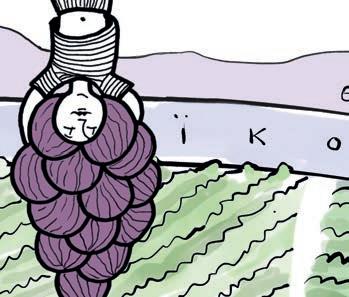













devoted to fine gastronomy, wine, travelling, and refined lifestyle.


A tasteful lifestyle journey by sip + bite
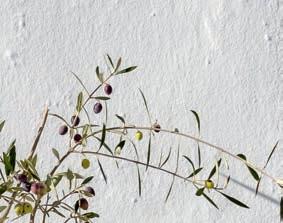























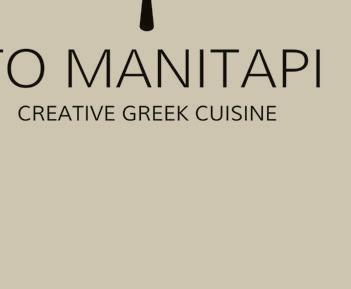






















devoted to fine gastronomy, wine, travelling, and refined lifestyle.


A tasteful lifestyle journey by sip + bite

































From the moment we’re born, food is much more than a biological need; it’s a ritual, an emotion, a memory. It’s a mother’s hand serving Sunday lunch, the laughter of friends gathered around a steaming hot dish, the silence of a dinner that speaks louder than a thousand words. It’s around the table that we meet as we truly are – without titles, without distance. That’s where the essence of sharing is born.
SIP+BITE was born from this very need: to be reminded that gastronomy is not just the art of good eating, but the experience of living and connecting through it. Tasting, experimenting, learning, offering. Every flavor, every texture, every scent is a story in itself, a place, a soul. And we want to tell it all!
WELCOME TO OUR TABLE!
You’ll find more than recipes on every page. You’ll embark on a journey through kitchens, cities, and villages. You’ll meet people who love food as much as they love life. You’ll discover ideas that spark creativity and affinity.
This first issue is the beginning of a new journey – a journey of flavors, stories, and emotions – and the latest addition to the collection of Cozy Publications. Let’s start this journey together, rediscovering the joy of sharing; where every bite and every sip becomes an experience and every experience a celebration of life…
ELENI MICHAILIDOU editor-in-chief @e.in.the.mix


Less for a life of more. Introducing the Essential Induction. The difference is Gaggenau
Experience it
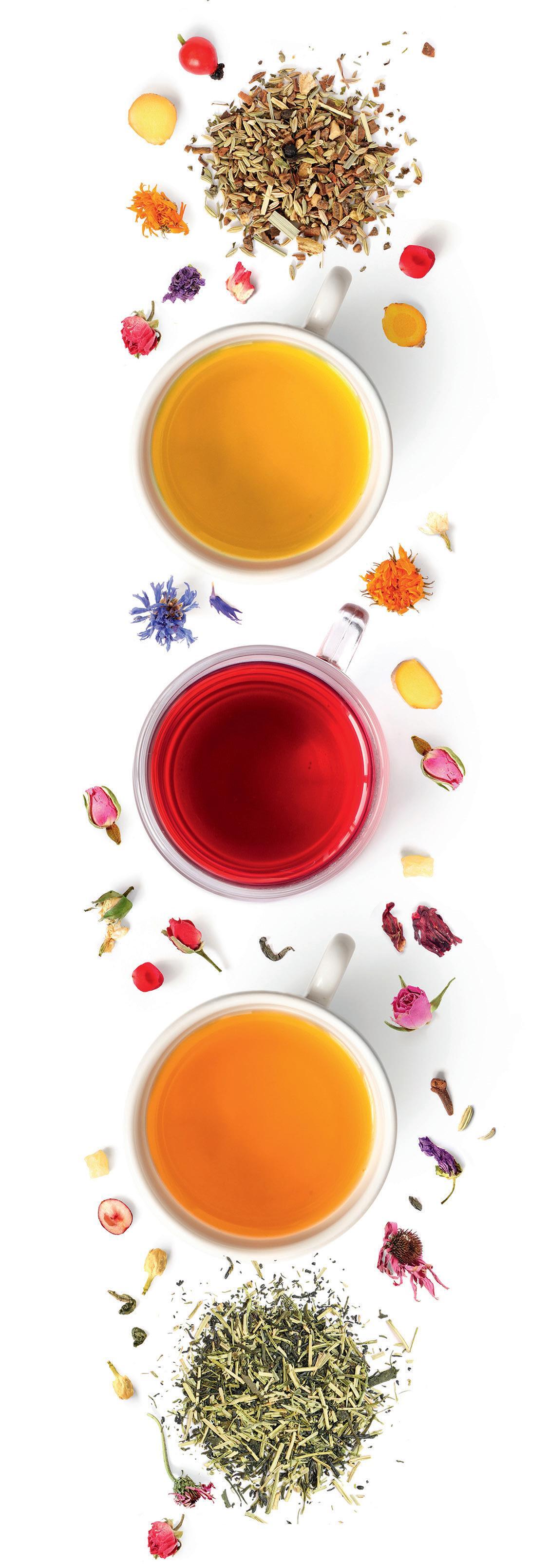
WORLD OF ESPRESSO 72 tasteful story PANAS HOLDING: FROM AN IDEA TO A LEGACY 74 fruit mocktails 100% PLEASURE, 0% QUILT WITH GREEN MOCKTAILS 76 celebrity cooking EFTHIMIS KALFAS: FOOD IS AN ACT OF LOVE
wine stories OLD VINES IN THE ERA OF CLIMATE CHANGE: MYTH OR SOLUTION? BY SOMMELIER / WINE CONSULTANT ALEXANDROS BOUZIKAS
4,99€


















PUBLISHER
PUBLISHING DIRECTOR
EDITOR-IN-CHIEF
CREATIVE ART DIRECTOR ARTICLES
Evi Papadopoulou evipapadopoulou@cozyhome.gr
Nasia Papadopoulou nasiapapadopoulou@cozyhome.gr
Eleni Michailidou elenimichailidou@cozyhome.gr
Despina Ioannidou
Mina Afentouli minaafentouli@cozyhome.gr
Manto Koronakou mantokoronakou@cozyhome.gr
Evaggelia Papapaschali evaggeliapapapaschali@cozyhome.gr
HEAD CHEF
FOOD PHOTOGRAPHER
FOOD STYLIST
WINE EXPERT
PHOTO AGENCIES
MARKETING DIRECTOR
MARKETING COORDINATOR
SALES & MARKETING
LEGAL ADVISOR
FINACIAL ADVISOR
PRINTING
Andreas Klavdianos
Theodosis Georgiadis Stavroula Foutsa
Alexandros Bouzikas
Shutterstock
Evi Papadopoulou
Natassa Apostolidou natassaapostolidou@cozyhome.gr
Revekka Tsiligkaridou revekkatsiligkaridou@cozyhome.gr
Iraklis Spanos & Associates
Iordanis A. Chatzimbaloglou
L. Akritidis Bros
PROPERTY COZY PUBLICATIONS
Α. Papadopoulou & CO L.P. 13th klm ThessalonikisN. Moudanion National Road 57001 Thessaloniki T. +30 2311 241524 sipandbite.gr ISSN: 3057-5036

THE MAGAZINE IS AVAILABLE FOR FREE. MAY NOT BE REPRODUCED, REPUBLISHED, COPIED, SOLD, TRANSMITTED, DISTRIBUTED, PUBLISHED, TRANSLATED OR MODIFIED IN ANY WAY, PARTIALLY OR SUMMARY OF THE CONTENTS OF THE FORM, TEXT AND PHOTOGRAPHS, WITHOUT THE PRIOR WRITTEN PERMISSION OF THE PUBLISHER.

reach for new heights, reach for patron el alto





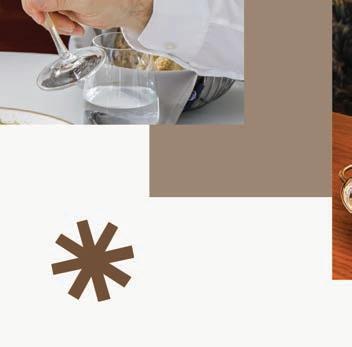










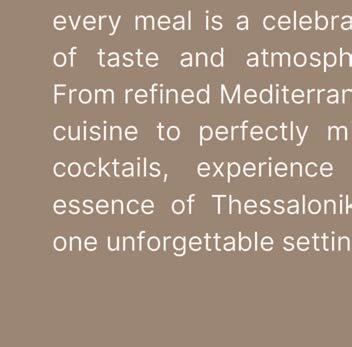





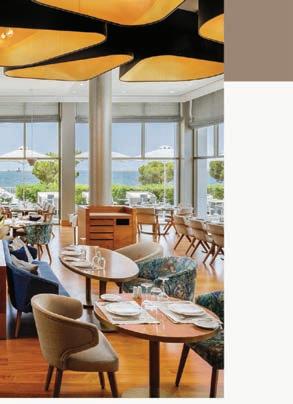

BY MANTO KORONAKOU
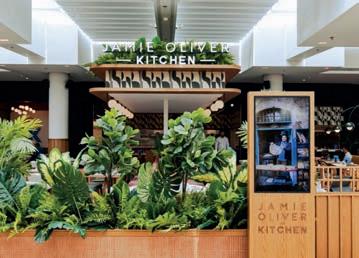

From
The first Jamie Oliver Kitchen in Greece is a fact! The renowned chef serves popular dishes on the second floor of the Golden Hall shopping mall in Marousi. Jamie Oliver Kitchen offers a modern and relaxed dining experience that blends Mediterranean flavors with international influences, bearing the signature of the celebrated English chef.
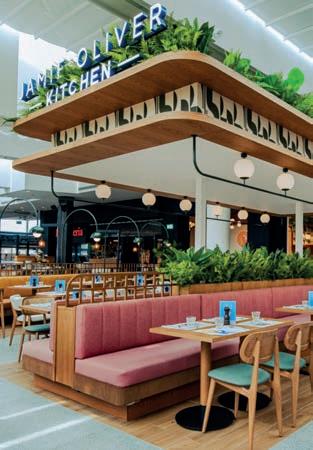


Framing Perfect Symmetry. Introducing the Gaggenau Expressive series. The difference is Gaggenau
Experience it

Το 2025, η Chizuko Kimura έγινε η πρώτη γυναίκα sushi chef παγκοσμίως
Sushi Shunei,
Edomae
Shunei
Michelin.
Chizuko Kimura became the first female sushi chef in the world to be awarded a Michelin star in 2025. This was achieved at Sushi Shunei, a traditional Edomae sushi restaurant in Paris, which she had founded with her late husband. After his passing in 2022, she took over the reins of the restaurant, fulfilling her promise to continue his legacy. Thanks to her dedication and technique, Sushi Shunei regained its Michelin star.


Το trend “New-stalgia”

Trafalgar στο Λονδίνο. Το ξενοδοχείο θα φιλοξενεί
The trend “New-stalgia” focuses on revamping classic dishes and flavors with a modern twist, reimagining comfort foods with fresh and innovative elements. By integrating familiar flavors and ingredients into new creations, emphasis is placed on bold combinations and creative presentations.
concept μέσα στο ξενοδοχείο.
The Waldorf Astoria London Admiralty Arch, expected to open in 2026, will be housed in the historic building across from Trafalgar Square in London. The hotel will feature two signature fine dining restaurants, overseen by Clare Smyth and Daniel Boulud. The Northern Irish Chef Patron of the 3* Core and the esteemed French Chef and Restaurateur will each introduce a unique, personal culinary concept to the hotel.
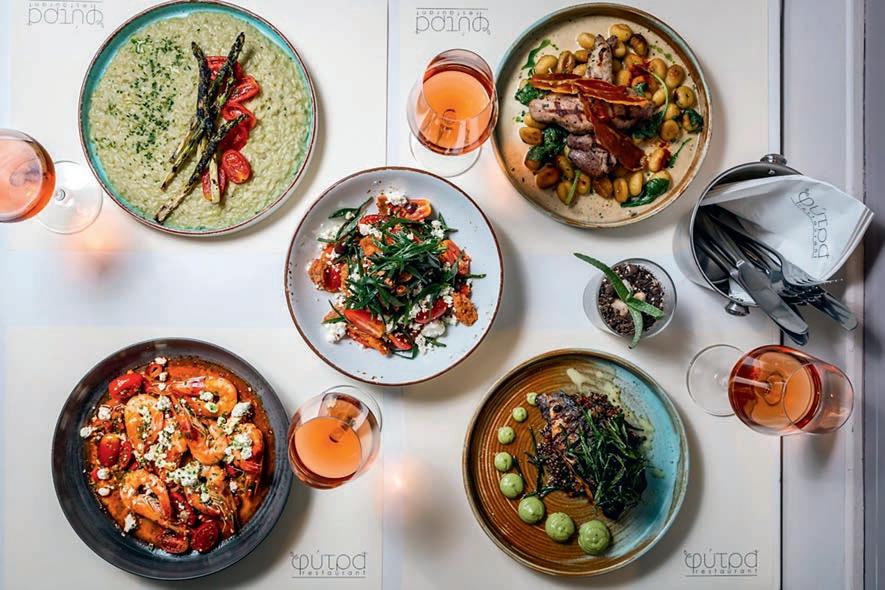


Το Central Perk Coffee Co.
FRIENDS.
Tom Colicchio, Top Chef
James Beard,

Central Perk Coffee Co. is set to open its doors in New York City’s Times Square, bringing a modern-day version of the legendary FRIENDS coffee shop to life. The new location is slated to open in late Fall 2025, offering visitors an immersive experience. Top Chef and James Beard Award winner Tom Colicchio, who was part of the original team for the inaugural Boston location, guided the menu.
Emmer & Rye,
τα Michelin-starred spots
Autry Park,
2025.


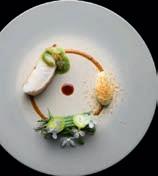
Emmer & Rye, the award-winning restaurant group known for its Michelin-starred spots in Austin, is set to open its first Houston restaurant, in Autry Park, in late 2025. The new restaurant marks the group’s first venture outside of Austin and San Antonio.
“The Great Book of the Sea” now speaks Greek, adapting the rich culinary heritage of the original French edition “Le Grand Livre de la Mer.” Its 296 pages are full of culinary knowledge, sustainable practices, techniques, as well as 80 recipes from distinguished chefs. The book presents the sea as a source of inspiration, raw materials, and culture, and serves as a valuable tool for professionals and seafood enthusiasts.



waste cocktails are a rising trend in the world of sustainable bartending. The goal is to minimize or even eliminate waste from materials, packaging, and daily operations. This trend is reinforced by increased environmental awareness, the principles of the circular economy, and the desire for luxury experiences combined with ecological responsibility.
Zero waste cocktails are a rising trend in the world of sustainable bartending. The goal is to minimize or even eliminate waste from materials, packaging, and daily operations. This trend is reinforced by increased environmental awareness, the principles of the circular economy, and the desire for luxury experiences combined with ecological responsibility.




































































































































PLAN G CATERING REDEFINES PREMIUM CATERING, BASED ON THE CULINARY PHILOSOPHY OF THE AWARD-WINNING RESTAURANT “TO MANITARI.” PLAN G GROUP IS BEHIND THIS CONCEPT, WITH EXPERIENCE IN HOSPITALITY AND EVENTS, INVESTING IN CONSISTENCY, AESTHETICS, AND PERSONALIZED SERVICE.
All meals are prepared by the “Manitari” team, with respect to raw materials and creative compositions that blend tradition with modern cuisine.
Plan G Catering aims to offer not only quality food but an integrated hospitality experience. With tailor-made menus, full equipment, a professional team, and flexibility, it provides solutions for every occasion – from elegant weddings and corporate galas to exclusive private events.
In a constantly evolving world, Plan G Catering remains committed to creating unforgettable experiences.

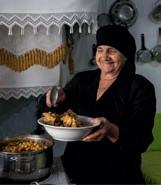
Crete was officially awarded the title of European Region of Gastronomy for 2026 by the International Institute of Gastronomy, Culture, Arts and Tourism (IGCAT). This prestigious distinction emphasizes the island’s devotion to culinary tradition, its commitment to sustainable food practices, and the ongoing promotion of its local cuisine.
Jan 31st- Feb 2nd _2026
H
expotrof.gr
EXPOTROF at MEC Paiania welcomes artisanal and delicatessen producers.
Mar 14th - 16th_2026
foodexpo.gr
The largest Food and Beverage exhibition in Southeastern Europe.
Mar 23rd - 29th_2026
Μια
thessalonikiwineshow.gr
A unique exploration of the world of wine.
Feb 14th - Mar 1st_2026

fete-du-citron.com
The Menton Lemon Festival transforms the French Riviera into a fairy-tale citrus celebration.
Mar 28th & 29th_2026
The VeggieWorld trade fair is coming to Düsseldorf to offer us a
Toni Chapman – or better known as The Moody Foody –is a famous chef and content creator focused on making cooking easy and fun. Her friendly and relatable style has captivated millions of fans on TikTok and Instagram. A few months ago, she released her first cookbook, “Everything’s Good”, featuring cozy recipes that you’ll want to cook over and over again!
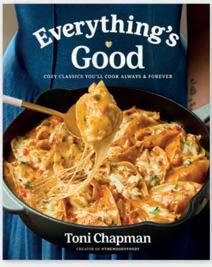









PAVLOS KYRIAKIS
BY ELENI MICHAILIDOU
From the 3* “Benu” in San Francisco and “Le Cinq” in Paris, to “Spondi” and “The Zillers” in Athens, and from opening his restaurant “Dodeka Piata” and “Kykloi by Priceless”, to the introduction of four hands dinners in Greece, Pavlos Kyriakis delves into the realm of culinary consistency, creativity, and distinctions. He is rightly considered to be one of the most influential chefs in Greece.
One of the most significant representatives of Greek fine gastronomy, Pavlos Kyriakis stays committed to one goal: cooking with originality and telling the story of Greece as it truly is – simple, profound, and truxqe.













Has there been a defining moment, a decision that you felt has forever changed your culinary path?
The most defining moment for me was the time I decided to send an email to the Michelin guide, requesting a visit to review my work at “The Zillers.” This move marked the turning point in my culinary career. It all happened after the second lockdown, when the restaurant opened, without any further closures. We then decided to focus on a more gastronomic approach.
Starting out, what was the biggest challenge you had encountered in the kitchen?
The greatest challenge was when I started working at “Spondi”, the second restaurant in my career. I was completely inexperienced, in a very demanding work environment – the restaurant had already received one Michelin star and aimed for a second. I had a hard time at the beginning, but after endless hours of work, great effort, dedication, and personal goals, I was able to stay and evolve as a chef.
Since then, in what way has the concept of “chef” changed in Greece?
I can’t say it has changed radically, but there’s certainly a misconception about the term. Many call themselves “chefs” without even having the basic competences for the position. Someone could work for five years, set up a small shop, and automatically refer to themselves as chef. The term has lost its essence for many as they simply don’t know what it truly entails.
In your opinion, what are the steps a person needs to take in order to truly earn this title?
First and foremost, I believe one needs to love the job. Being a chef means more than just managing a kitchen. There are many different kinds of chefs – good, average, excellent. The difference lies in the countless hours of work, collegiality, and consistency. It takes time to evolve. Unfortunately, many people opt for the easy path.
Is talent a crucial factor in fine gastronomy?
Yes, but talent alone is not enough. Just like in any form of art or profession – whether you are an athlete, a musician, or a painter – talent is cultivated through daily practice and work. Talent is the starting point, but progress is the result of hard work and perseverance.
Do you believe that Greek cuisine has found its own “voice”?
Little by little, progress is being made. The new gener ation is effectively engaged in Greek cuisine, tracing its origins and creating dishes based on locality and tradition. Local ingredients are used, depending on the region – islands, mountainous regions, etc. This changes the perception of Greek cuisine and elevates it. At the same time, Greek producers play an integral role –we have excellent olive oil, varieties of cheese, and raw materials. It’s not just the chefs and restaurants; it’s a collective endeavor.
In your opinion, what strikes a fine balance between respect for tradition and the need for innovation?
You first need to know the basics in order to innovate. If someone calls him/herself a chef after a few years and doesn’t
I AM VERY MUCH INSPIRED BY TRAVELING ABROAD.
I EXPLORE LOCAL CUISINES, OBSERVE, LEARN, AND TRY OUT TRADITIONAL DISHES. THIS «NURTURES» MY CREATIVITY.
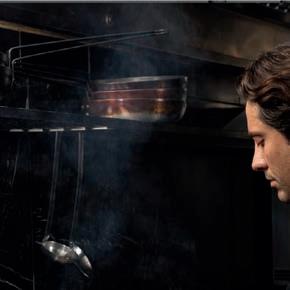




even know the basic traditional dishes, what exactly will he/she be able to elevate? You can’t “tweak” something you don’t understand. You must first learn to cook legumes, vegetable dishes, and how to properly cook a fish or a piece of meat. Then, you can proceed with the creation of innovative versions. Was this your inspiration behind “Dodeka Piata”?
“Dodeka Piata” is a very personal project, one that I’ve been thinking about for years. I wanted to create a space where food would align with what I would like to eat when dining out. I believe that “gastro-taverns” and overly tweaked dishes have become wearisome. I feel that there is lack of authenticity, so I chose to create something simple, yet true.
Every restaurant bearing your signature has a distinct, curated culinary identity. Where does the inspiration for such an experience come from?
First and foremost, the location. If, for example, the restaurant is in Santorini or Crete, it is influenced by local products and traditional recipes native to the region. If it’s near the sea, the menu is more fish oriented, while if it’s located on the mountain, it includes more meat or game. The target customers also play a significant role – whether it’s families or adults only. Typically, in a hotel, we endeavor to present a tavern-style restaurant serving Greek cuisine, and a second one, featuring culinary flavors.

Is there an ingredient or a technique that you consider overrated? And respectively, is there anything that remains unexplored?
I wouldn’t put it that way. The thing is that everyone is working with caviar, yet ignoring the richness of fish roe. In general, we don’t have satisfactory knowledge of our own raw materials. There is still work to be done in that area.
If you could “recreate” a code for the Greek cuisine of future generations, what would you change or add?
My advice for the younger generation would be to embrace their roots. They should immerse themselves in the local and family recipes of each region – not just the “classic” dishes we are all familiar with. Greek cuisine is not just moussaka, pastitsio, and tzatziki – it’s so much more, and it needs to be unveiled.
What inspires you, apart from gastronomy? Is there any form of art or any experience that might influence the creation of a dish?
I am very much inspired by traveling abroad. I explore local cuisines, observe, learn, and try out traditional dishes. This «nurtures» my creativity.
And lastly, what does “having a voice” as a chef nowadays mean to you? Is it a matter of technique, identity, or something deeper?
Having a voice as a chef is a matter of identity and originality. The technique is a given – everyone now knows the basic techniques. The ingredients are also common to all. Your personal truth and your ability to reflect that in a dish is what stand out. Don’t imitate, don’t copy. Be yourself – that’s what makes you unique. ■

ΑΓΑΠΗΜΕΝΟ COMFORT FOOD,
Follow @pavlos_kiriakis
FAVORITE COMFORT FOOD, WHEN NO ONE IS WATCHING: Ground beef pasta – no matter who’s watching! (laughter)

AN INGREDIENT NEVER MISSING FROM YOUR KITCHEN: Salt.
THE RESTAURANT EXPERIENCE THAT LEFT AN INDELIBLE MARK– IN GREECE OR ABROAD –: “Spondi” in Greece and, “Benu” in San Francisco.
IF YOUR COOKING WAS ACCOMPANIED BY A SOUNDTRACK: It would definitely be Metallica!
THE MOST HEARTFELT COMMENT YOU HAVE EVER RECEIVED ON ONE OF YOUR DISHES: It was from a French customer at “The Zillers”. I had “experimented” with a traditional French dessert, and when she tried it, she was deeply moved. She told me it brought back the memory of her favorite childhood dessert, just like the one her grandmother used to make.
New COCO-MAT
Athens bc menu
ΝΗΣ Ι ΤΗΣ ΚΑΛΥΨΩΣ (ΜΑΛΤΑ)



Fish soup with saffron and vegetables, meagre carpaccio, and marinated mussels
(MESSINA)
Arancini with Messina pistachio, coated in carob, fresh mozzarella cream, and prosciutto powder
HADES
Espresso mousse with milk caramel mocha, pomegranate sauce, and cinnamon sponge
THE SIRENS (AMALFI)
Seared meagre with truffle honey and miso, celery root purée, wild greens, crispy cuttlefish ink, and sea lettuce powder
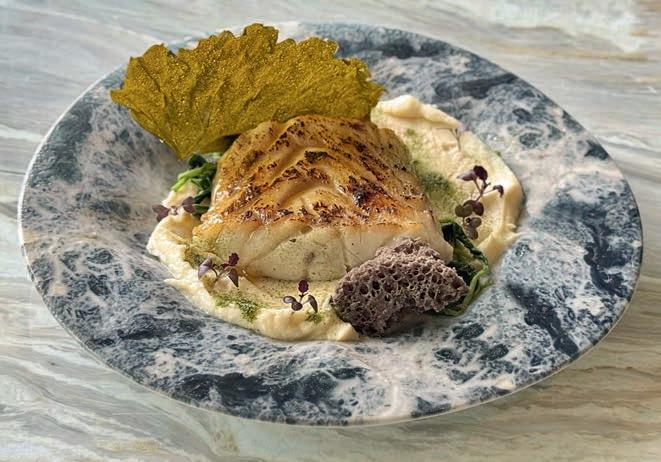
The new menu of COCO-MAT Athens BC is an invitation to embark on a journey that unites mythology, Mediterranean tradition, and contemporary creative cuisine — a voyage of taste and imagination, from Troy to Ithaca.
During a trip to Italy, as I reached Calabria to cross over to Sicily, I noticed a sign referring to Scylla and Charybdis. Sailing through the Strait of Messina and reading about the island’s gastronomic history and its ancient Greek past, I realized that many of the places I was visiting were in fact stops in Odysseus’s mythical voyage home to Ithaca.
That is how the idea was born — to let the new menu of COCO-MAT Athens BC follow, through gastronomy, the journey of the hero himself.
Each dish we created, together with pastry chef Theodosia Ioannou, tells the story of a different stop along Odysseus’s adventure.
Chef d’ hôtel Konstantinos Tsouchlaris
BY MINA AFENTOULI

Rich in nutrients and beneficial for health, seeds confirm the saying... small but mighty!
Chia seeds increase the feeling of fullness and decrease appetite. When consumed, they absorb water and expand in size. This slows down digestion and nutrient absorption, therefore helping you feel fuller.
NUTRITION FACTS: Dietary fiber, Omega-3 fatty acids, antioxidants, and proteins, vitamins and minerals such as calcium, magnesium, and phosphorus.
HOW TO EAT: Sprinkle on yogurt and add to cereals or salads, smoothies, or soups, even pancake batter. You can make chia pudding with milk, water, or yogurt. Πλούσιοι
A popular superfood, flaxseed, contains lignans, antioxidants which help balance hormone levels. It improves digestion, contributes to skin and heart health, and regulates cholesterol levels.
NUTRITION FACTS: Very rich in dietary fiber and protein, and one of the best plant-based sources of Omega-3 fatty acids.
HOW TO EAT: Prefer ground flaxseed and sprinkle on yogurt or add to smoothies and baked goods. You can also use it as an egg substitute.
In many countries, pumpkin is used as a medicine for its antiinflammatory, antioxidant, antiviral, and antidiabetic properties. Its seeds are relatively large with a high content of polyunsaturated and monounsaturated fatty acids.
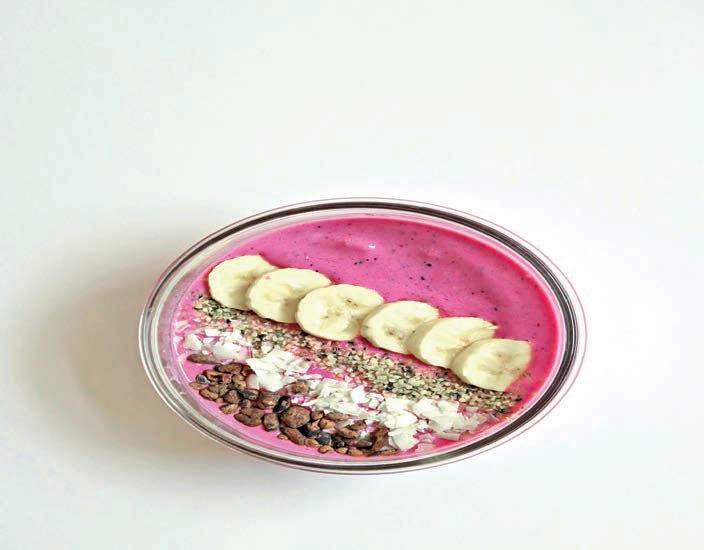
Pumpkin seeds are rich in antioxidants, healthy fats, and minerals. A source of healthy fats, magnesium, and antioxidants, they have high vitamin E content and are rich in the amino acid tryptophan. Besides being a great stand-alone snack, they are a nice addition to salads or homemade granola with
Sunflower seeds have multiple health benefits, including cholesterol reduction, cardiovascular disease prevention, and antioxidant
NUTRITION FACTS: They are one of the best sources of iron, rich in selenium, zinc, phytosterols, magnesium, vitamin E, and folic acid, and an excellent source of protein.
HOW TO EAT: A great snack to have on hand –shelled or unshelled, roasted or raw – sunflower seeds can be incorporated into salads, smoothies, or yogurt. You can also add them to baked goods, such as bread or breadsticks. ■
BY MANTO KORONAKOU

Healthy eating starts in the kitchen. With the right “tools”, cooking will be enjoyable, and healthy eating will become a way of life!
The food steamer is your No. 1 ally for a healthy meal preparation. It’s a versatile kitchen appliance that cooks food using steam instead of direct heat. This method retains the vitamins, minerals, and antioxidants in food, making it ideal for those seeking a healthy way of cooking.
Wondering how to satisfy fried food cravings without guilt? Air-fryer is the solution! The air-fryer is an innovative kitchen appliance that cooks food using hot air instead of oil or fat. This rapid circulation of hot air creates a crispy texture similar to frying, but with significantly fewer calories and less fat.
The electric grill is an extremely practical and user-friendly appliance that brings the taste and pleasure of grilled food indoors, without the need for charcoal or gas. With the help of the electric grill, meat, fish, vegetables, and more, can be cooked to perfection.
Consuming fresh juices helps increase energy levels, remove toxins, and support the immune system, making the juicer a valuable ally for a healthy and balanced lifestyle. Experiment with a variety of fruit and vegetables and enjoy a colorful energy boost!
From velvety vegetable soups and delightful smoothies to unique dressings that will elevate your dishes, the blender makes everything easy, quick, and... healthy. Create your favorite recipes with few ingredients in no time. ■
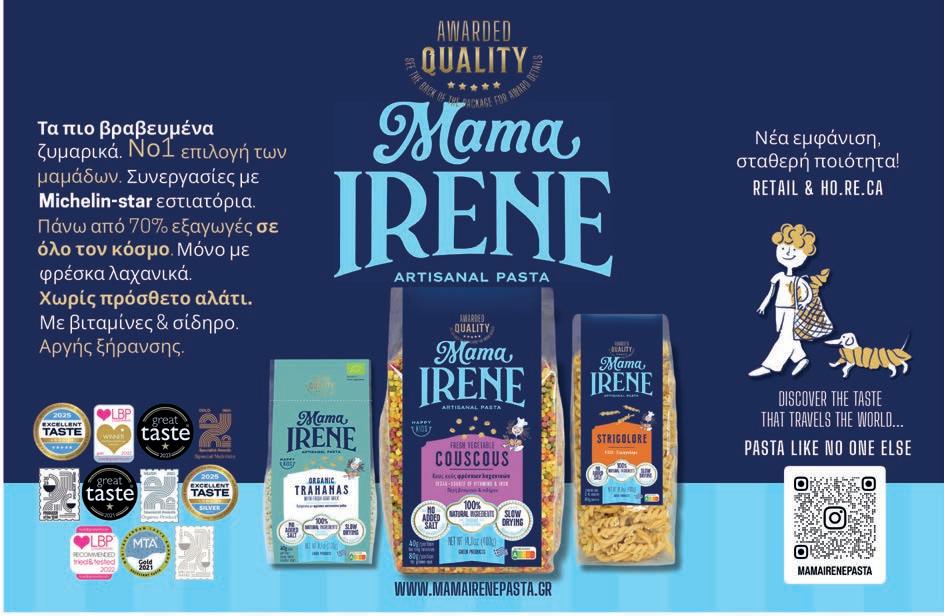


Every delicious creation starts with inspiration, quality ingredients and the right tools that make the cooking process easier and more enjoyable. From durable utensils and ergonomic knives to mixers and mandolines, at Cook-Shop you will find everything you need to turn every recipe into a small work of art.














FOOD PHOTOGRAPHER: THEODOSIS GEORGIADIS_FOOD STYLIST: STAVROULA FOUTSA
A GASTRONOMIC JOURNEY THROUGH SMYRNA, ASIA MINOR, AND PONTUS, PRESENTED WITH A MODERN AND CREATIVE APPROACH.
Aegina pistachio kernels, ground N N Z Z
TSOUMOUR
8 slices of stale bread without crust, 4 cm thick
4 eggs
200 g sugar
100 g honey
50 g fresh butter at room temperature
100 g fresh butter for sautéing
Cinnamon
Shelled pistachio butter
Add half of the butter in a pan, sauté the bread, then remove and drain on paper towels. Crack the eggs and whisk in a bowl. Add the bread and sauté again until golden brown. Remove again and drain on paper towels.Add the soft butter, sugar, and honey in a bowl, and mix until well combined. Spread the mixture over the bread slices and bake in the oven at 200°C for 5´, until caramelized.
SERVE ON A PLATTER AND SPRINKLE WITH CINNAMON, SHELLED PISTACHIO BUTTER, AND GROUND AEGINA PISTACHIOS.



FOR THE EGGS
8 eggs
Salt
Pepper
150 g cherry tomatoes, quartered
100 g feta cheese
50 ml heavy cream
5 parsley sprigs, finely chopped
30 ml olive oil
FOR THE TOMATO SAUCE
1 medium tomato, finely chopped
40 ml olive oil
250 g tomato juice
2 pinches of sugar
Salt
Pepper
1 tbsp white vinegar
1 green horn pepper, roughly chopped
FOR THE FETA SAUCE
100 g crumbled feta cheese
150 g heavy cream
1 pinch of pepper
20 g fresh butter
1 g garlic pulp
Salt
TO SERVE
2 fresh oregano sprigs
2 parsley sprigs
4 finely chopped pitted olives
Olive oil
FOR THE TOMATO SAUCE
Warm half of the olive oil in a small saucepan over medium heat. Add the chopped tomato, green pepper, sugar, salt, and pepper. Let it simmer and stir until most of the liquid evaporates and the sauce is reduced by half. Add vinegar and let it sit for 1´. Add the tomato juice and let it boil for another five minutes until the sauce thickens. Lastly, add the remaining olive oil.
FOR THE FETA SAUCE
Place all ingredients in a small saucepan and stir over low heat for 4´. Using an immersion blender, blend the sauce until smooth.
FOR THE EGGS
Crack the eggs into a bowl and whisk well with the remaining ingredients. Place a non-stick tray in the air fryer basket and spray it with olive oil. Pour in the egg mixture and bake at 200°C for 15´. Let the omelette cool for 4´.
SERVE THE OMELETTE IN PIECES, AND TOP WITH THE TOMATO AND FETA SAUCE. GARNISH WITH OLIVE OIL, HERBS, AND OLIVES.
OTIA
FOR THE DOUGH 4 eggs
250 g strained yogurt
1/2 cup fresh milk
1/3 cup sunflower oil
1 cup sugar
Zest of 1 orange
3 pinches of salt
2 tsp baking powder
1/2 tsp baking soda
4 cups all-purpose flour
Sunflower oil, for frying
Extra flour, for rolling the dough
FOR THE HONEY SYRUP
125 g sugar
250 g water
125 g honey
Juice of 1 lemon
TO SERVE
Zest of 2 oranges
150 g Aegina pistachio praline
50 g Aegina pistachio, powder N N Z Z
FOR THE DOUGH
Whisk the eggs, yogurt, milk, sunflower oil, sugar, zest, and salt in a large bowl, until well combined. Mix half of the flour with the baking powder and baking soda, sift, and add to the mixer. Knead the mixture using your hands or a mixer with a dough hook. Continue, gradually incorporating the remaining flour into the dough.
Shape dough into a ball and let it rest for 15-20´.
Divide dough into 5 balls, place on a floured tray, and allow to rest for 40´. On a floured surface, roll out each ball with a rolling pin to 1 cm thick, and then cut into 2 cm strips. Cut each strip into 5 cm long diamond shapes, and make a hole in the center with a knife. Hold one end and pass it through the hole to resemble a little ear.
Deep fry the otia in hot oil, pressing and stirring with a slotted spoon for about 2´. Once they turn golden, place onto a platter lined with paper towels.
FOR THE SYRUP
Boil all ingredients for 3´ in a small saucepan.
DRIZZLE SYRUP AND PRALINE OVER THE OTIA, SPRINKLE WITH ORANGE ZEST AND PISTACHIO POWDER, AND SERVE.

PIROSHKI
FOR THE DOUGH 850 g flour
450 g lukewarm water
2 packets dry yeast
1 level tbsp salt
1 level tbsp sugar
A little sunflower oil
Sunflower oil for frying
FOR THE FILLING
600 g crumbled feta cheese
300 g tomatoes, diced and drained 30 g olive oil
1 g oregano
1 chili pepper, finely chopped
FOR THE SAUCE
300 g Florina peppers, canned 30 g yogurt
2 g chili flakes
50 g olive oil
TO SERVE
4 parsley sprigs, finely chopped Chili oil
FOR THE FILLING
Gently mix all ingredients in a bowl.
FOR THE SAUCE
Blend all ingredients and place in a small bowl.
FOR THE DOUGH
Add the lukewarm water and dry yeast in a bowl. Stir until dissolved. Place the flour, salt, and sugar in the bowl of a mixer with a dough hook. Add the dissolved yeast and knead until you get a smooth dough. Let the dough rest until it doubles in volume. Shape into 30 g balls, roll them out with a rolling pin, place the filling inside, seal firmly, and fry at 160-170°C until golden.
SERVE THE PIROSHKI ON A PLATTER, AND GARNISH WITH A LITTLE CHILI OIL AND PARSLEY. ENJOY, DIPPING THE PIROSHKI INTO THE SAUCE.

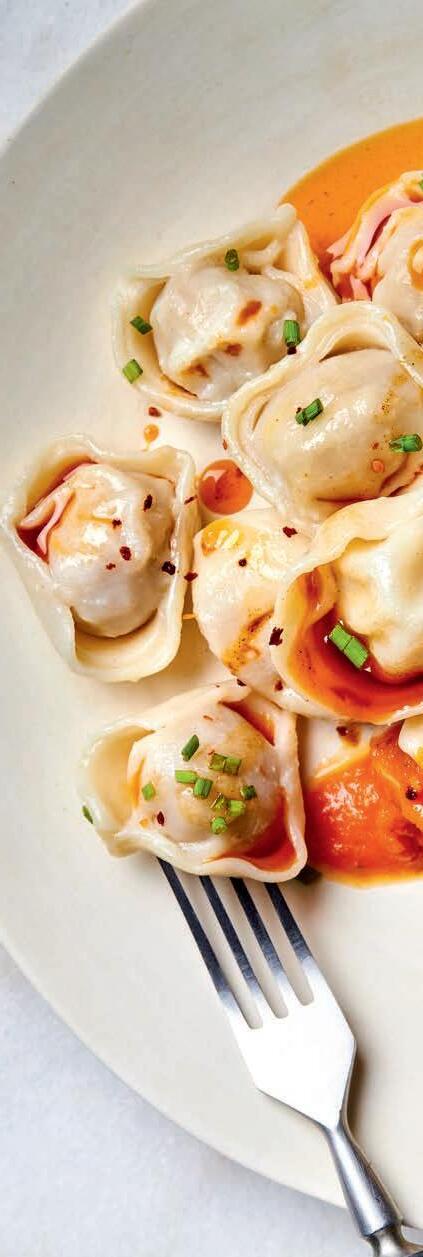
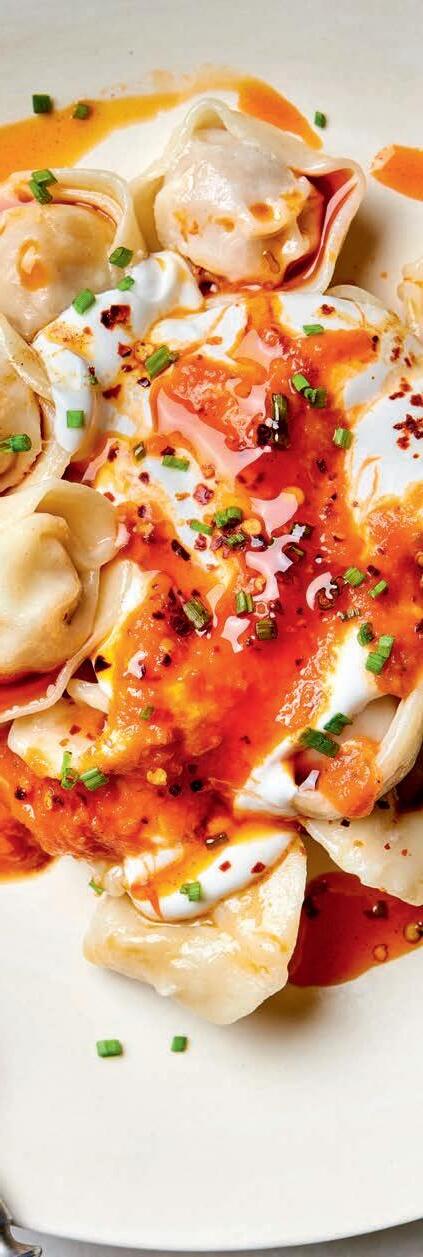
FOR THE DOUGH
225 g flour
3 g salt
2 eggs 40-60 ml water
FOR THE FILLING
225 g shrimp meat
1 small white onion, finely chopped and sautéed 1/2 pinch of cinnamon
1/2 pinch of clove
5 parsley sprigs, finely chopped 4 g salt
FOR THE FILLING
Grind all the ingredients into a paste in a blender. Divide into 8-gram balls.
FOR THE DOUGH
In a bowl or a mixer with a dough hook, knead all the ingredients until you get a smooth dough. Let it rest at room temperature for about 45´. Roll the dough into a thin sheet and cut it into 8 squares. Place a filling ball on each square and seal firmly.
FOR THE SHRIMP SAUCE
In a large pot, sauté the shells in olive oil. Add carrots, onion, celery, pepper, and garlic, and sauté for 2´. Add the tomato paste and sauté for 1´. Deglaze with wine and, once it has evaporated, add the fresh tomato. Cover the ingredients with water and boil until the liquid is
FOR THE SHELLFISH SAUCE
Shrimp shells
30 ml olive oil
3 carrots, sliced
2 red onions, thinly sliced
1 celery stalk, roughly chopped
1 Florina pepper, roughly chopped
1 garlic clove
30 g tomato paste
1 glass white wine
2 tomatoes, roughly chopped
30 g fresh butter
FOR THE YOGURT SAUCE
120 g strained yogurt
30 g ayran
20 ml olive oil
1 pinch of salt
TO SERVE
Olive oil
Chives Aleppo pepper
reduced by half. Blend with an immersion blender, strain the sauce through a sieve, and transfer to a small pot. Boil until it thickens. Remove from heat, season with salt and pepper, add the fresh butter, and stir gently.
FOR THE YOGURT SAUCE
Mix all ingredients in a bowl until well combined.
BOIL THE MANTI IN A POT OF SALTED BOILING WATER FOR ABOUT 4´. SERVE ON A PLATTER, SPOON THE SHRIMP AND YOGURT SAUCES OVER THE TOP. DRIZZLE WITH OLIVE OIL, CHIVES, AND ALEPPO PEPPER.

CABBAGE SALAD
FOR THE PICKLED CABBAGE
1/2 cabbage
900 g white vinegar
500 g water
300 g sugar
100 g salt
FOR THE PICKLED CELERY
2 celery stalks
180 g white vinegar
100 g water
60 g sugar
20 g salt
FOR THE ROASTED CARROTS
500 g carrots, peeled 2 garlic cloves
3 fresh thyme sprigs
50 g fresh butter
50 ml olive oil
Salt - Pepper
FOR THE HONEY VINAIGRETTE
300 ml sunflower oil
100 ml white balsamic vinegar
2 tbsp Dijon mustard
2 tbsp honey
1 pinch of salt
FOR THE CRISPY PASTIRMA
300 g bread
50 g pastirma, finely chopped
70 g fresh butter
FOR THE PICKLED CABBAGE
Boil all ingredients except the cabbage, and set aside to cool. Slice the cabbage into thick pieces and place in the brine. Refrigerate for at least one day.
FOR THE PICKLED CELERY
Boil all ingredients except the celery, and set aside to cool. Remove the celery strings with a peeler, thinly slice it, and place it in the brine. Refrigerate for one day.
FOR THE ROASTED CARROTS
Mix the carrots with all the ingredients, place on a baking tray lined with parchment paper, and bake in a preheated oven at 170°C for about 45´. Remove from the oven and set aside to cool.

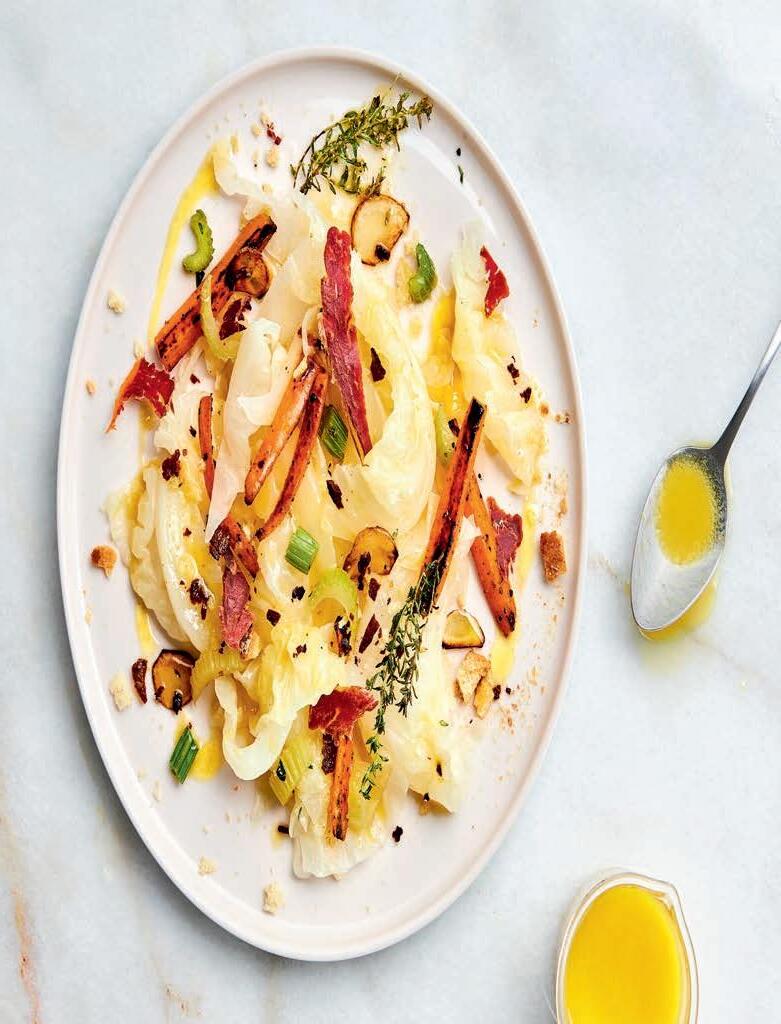
FOR THE HONEY VINAIGRETTE
Add all ingredients except the sunflower oil in a jug. Blend with an immersion blender and very slowly drizzle in the sunflower oil (“like a string”) until fully incorporated.
FOR THE CRISPY PASTIRMA
Grind all ingredients together in a blender. Spread the mixture on a baking tray lined with parchment paper and bake at 150°C until golden. Remove from the oven and set aside to cool.
FOR THE SALAD COMPOSITION
Remove the cabbage and celery from the brine and drain. Cut the cabbage and carrots into smaller pieces, place on a platter, and drizzle with a little vinaigrette. Add the celery and the crispy pastirma.
Salt - Pepper N N Z Z
LYTHRI - STYLE CALAMARI
2 kg calamari, rinsed and cut into thick rings
250 g green cracked olives, pitted
200 g olive oil
150 g white wine
3 large tomatoes, roughly chopped
200 g tomato juice
2 onions, sliced
1 bunch of parsley
Sauté the onions in olive oil until soft, in a shallow pot. Add the calamari and sauté a bit longer. Deglaze with wine and bring to a boil. Add the tomato juice, parsley, and season.
Lastly, once all liquid has evaporated, add the roughly chopped tomatoes and olives and cook for another 3´.
OPTIONALLY, SERVE WITH BOILED POTATOES OR PILAF.
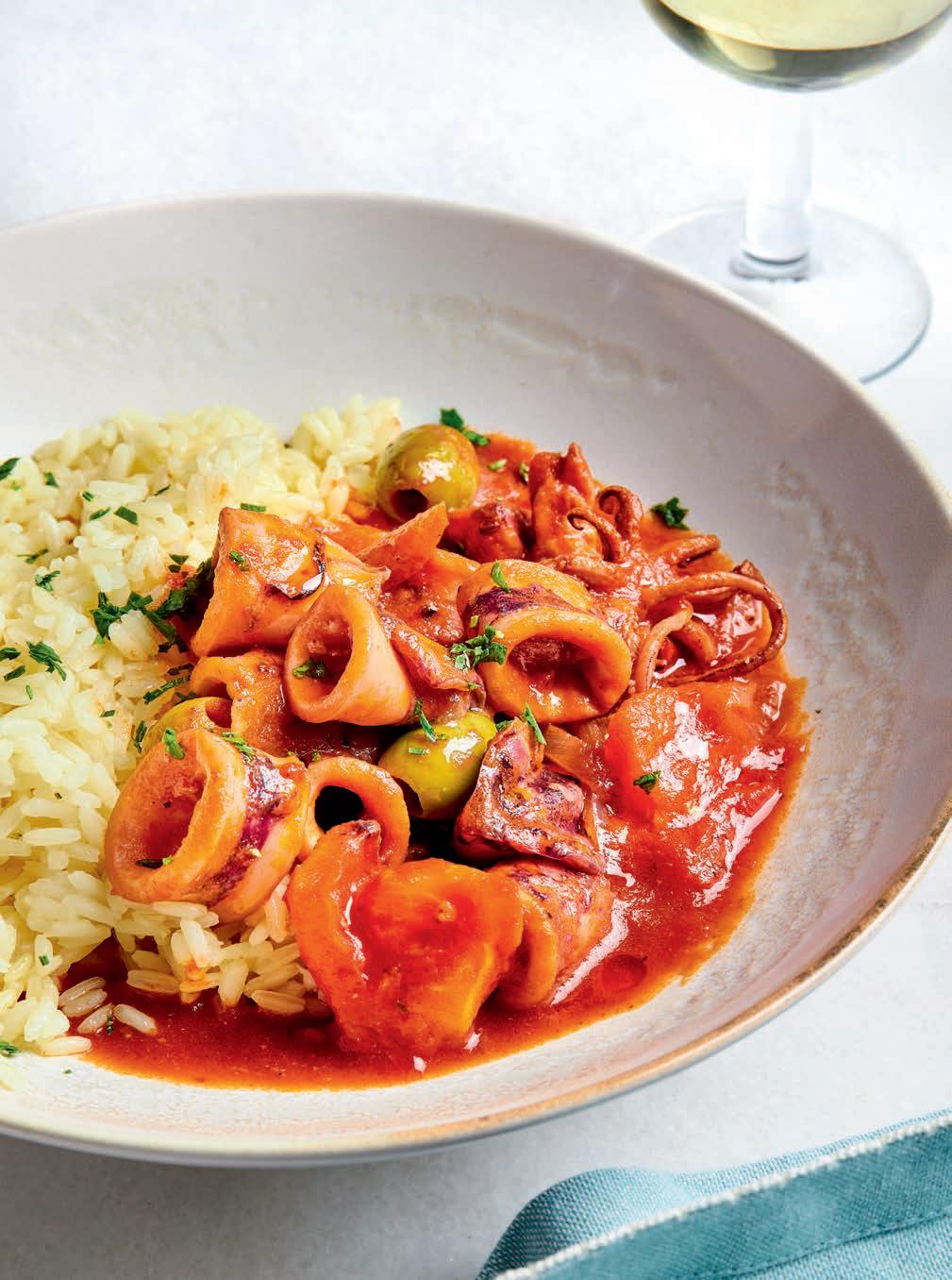
N N Z Z
LENTIL SALAD
500 g thick lentils
300 g unsalted mizithra cheese
1/2 a bunch of dill
1/2 a bunch of parsley
3 spring onions, finely chopped 2 g paprika
1 g pepper
1 g cumin
Salt
Olive oil
Vinegar
Add the lentils in a pot of boiling water and boil for 20 minutes until al dente. Drain, rinse with cold water, and set aside to cool.
PLACE THE LENTILS WITH ALL THE INGREDIENTS IN A BOWL, AND GENTLY TOSS.

SMYRNA - STYLE PILAF
FOR THE PILAF
1 1/2 cups Carolina or Bomba rice
1 large red onion
1 small cinnamon stick
1 clove
3 allspice grains
2 cardamom pods
4 strands of Kozani saffron
80 ml olive oil
Salt
100 ml water N N Z Z
3 cups chicken broth
FOR THE RAISIN MARMALADE
300 g golden raisins
100 g black raisins
100 g pine nuts
30 ml cognac
100 g brown sugar
50 g honey
Place a baking pan on the hob, add the olive oil, and sauté the rice. Add the chicken broth and spices and continue sautéing, stirring constantly. Remove the spices and place the pan in a preheated oven at 180°C. Cook until all liquid is absorbed. If needed, add a little broth until the rice caramelizes. Remove the pilaf from the oven and set aside to cool. Use a spatula, fluff and fold the rice into rolls or cut into large pieces and place on a serving platter.
Place all ingredients in a small saucepan and cook for about 10´ over low heat to combine well.
SERVE THE PILAF AND GARNISH WITH THE MARMALADE.

SMYRNA - STYLE SOUTZOUKAKIA
FOR THE SOUTZOUKAKIA
1 kg ground beef
1 large red onion, grated
300 g stale bread, grated 2 g pepper
14 g salt
1 egg 1 g cumin 75 ml olive oil
FOR THE SAUCE
3 large ripe tomatoes, grated 150 ml olive oil
1 lt water
1 level tbsp tomato paste
30 g sugar
15 g salt
2 g pepper
TO SERVE
3 large potatoes, peeled N N Z Z
3 green horn peppers, sliced 2 tomatoes, sliced
FOR THE SOUTZOUKAKIA
Place all ingredients in a bowl and mix well. Refrigerate for 10´ to firm up the mixture, then shape into soutzoukakia weighing 30-40 g each. Cook in the air fryer for 15´.
FOR THE SAUCE
Sauté the tomato paste for 2´ in a small pot with olive oil. Add the grated tomatoes, salt, and pepper, and simmer until the sauce thickens.
TO SERVE
Slice the potatoes and cook them in the air fryer until tender and golden. Follow the same procedure for the peppers and tomatoes.
ARRANGE THE POTATOES IN AN OVENPROOF DISH AND POUR HALF OF THE SAUCE. LAYER THE SOUTZOUKAKIA, PEPPERS, AND TOMATOES. POUR THE REMAINING SAUCE ON TOP AND BAKE IN THE OVEN FOR ABOUT 15´ AT 180°C.

N Z Z
SMYRNA - STYLE EGGPLANTS
FOR THE EGGPLANTS
6 large peeled eggplants
100 g breadcrumbs
100 ml olive oil
Salt
FOR THE FETA SAUCE
250 g feta cheese
200 g milk Pepper Cornstarch (optional)
FOR THE TOMATO SAUCE
200 g tomato juice
20 g sugar
30 ml olive oil
2 onions, sliced 1 garlic clove, grated 6 parsley sprigs, finely chopped 1 tomato, diced
TO SERVE
50 g feta cheese 10 peperoncini
FOR THE EGGPLANTS
Cut into ½ cm slices and bake at 180°C with a little olive oil until soft. Line a baking tray with parchment paper, layer eggplants, breadcrumbs, and salt alternately. Cover with aluminum foil and bake for 20´ at 180°C. Let cool, refrigerate for 3-4 hours. Cut into 4 cm pieces and bake again for 8–10´at 180°C.
FOR THE FETA SAUCE
Heat all ingredients over low heat until the feta cheese melts. Blend with an immersion blender until smooth. Add cornstarch if needed.
FOR THE TOMATO SAUCE
Sauté onions and garlic in olive oil until caramelized. Add sugar, tomato juice, salt and pepper, parsley, and tomato. Simmer until thickened.
TO SERVE
Fry the peperoncini and crumble the feta cheese.
SPREAD FETA SAUCE ON A PLATTER, PLACE THE EGGPLANTS, POUR OVER TOMATO SAUCE, SPRINKLE WITH CRUMBLED FETA, AND GARNISH WITH PEPERONCINI.

OVEN-BAKED RICE PUDDING FOR THE RICE PUDDING
150 g round grain rice, rinsed
750 g boiling water
1 lt milk
200 g sugar
2 egg yolks
70 g cornstarch
FOR THE CREME ANGLAISE
200 g milk
200 g heavy cream
4 egg yolks
125 g granulated sugar
1 vanilla pod
FOR THE RICE PUDDING
Place the rinsed rice in a pot with boiling water, and stir until the water evaporates. Then, add half of the milk and the sugar and continue cooking. In a bowl, dissolve the cornstarch in the remaining milk. Pour the mixture into the pot and stir until thick. Fill 6 ovenproof bowls (yogurt-sized) using a ladle, place in a baking tray, and add hot water. Bake in a preheated oven at 180°C for 20-25´.
FOR THE CREME ANGLAISE
Place the heavy cream and milk in a small pot. Add half of the sugar without stirring, to prevent the milk from scorching. Before it starts to boil, stir and remove from heat. Whisk the egg yolks with the remaining sugar and the vanilla in a bowl until the mixture is fluffy. Take a spoonful of the milk mixture, pour it into the yolks and stir. Repeat once more. Pour the egg mixture back into the pot with the milk mixture and cook until it reaches 85°C. Remove the pot from heat and strain through a sieve. Allow to cool.
CREATE A HOLE IN THE RICE PUDDING AND ADD THE CREME ANGLAISE.








ΗΡΙ RIEDEL, SET OF 2 RIEDEL WHITE




ΣΑΛΑΤ ΙΕΡΑ ΣΕ ΙΡΑΣ COPPA KURO, ASA SELECTION, ΠΑΡΟΥΣ
COPPA KURO SALAD BOWL, ASA SELECTION, PAROUSIASI
ΚΑΡ Α ΦΑ 750ML ZWIESEL GLAS,
750 ML CARAFE, ZWIESEL GLAS, PAROUSIASI WINE GLASSES, PAROUSIASI




BY ELENI MICHAILIDOU
gerovassiliou.gr
Lush, harmonious, and beautifully citrus-tinged, Ktima Gerovassiliou White – a sophisticated blend of Malagousia and Assyrtiko – is an aromatic wine that elevates seafood, fish, white meats, and pasta dishes with effortless finesse. Blending Syrah, Merlot, and Limnio, Ktima Gerovassiliou Red reveals a layered bouquet of spices and ripe black fruits, complemented by polished tannins that convey both depth and impeccable balance.

must try

TASTE ABOVE ALL @Fytra_restaurant
The chef-owner of Fytra once again demonstrates how even the humblest ingredients – pulses among them –can be transformed into gastronomic treasures. Be sure to try the chickpea fritters with bean purée; they are unforgettable.

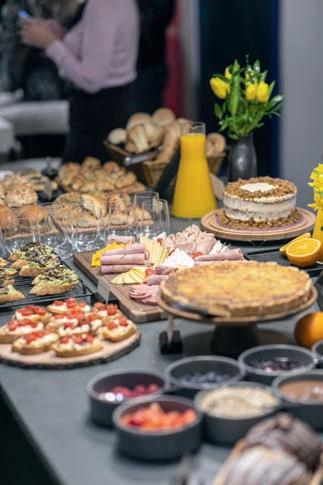

Imagine a house that is made to gather people. A huge kitchen that smells of home energy, a sofa that can fit the whole group and a mood that says only one thing: “Elate! (Come!)” Welcome to eláte Private Cooking & People Gathering, the coolest spot in town to experience the ultimate home gathering – even if it’s not your own home. The idea was born from Efthimis and Georgia, two friends who loved to cook and fill the house with people. Now, they give everyone the opportunity to do so: from private dinners and thematic parties, to corporate meetings, baby showers or Eurovision and Champions League nights, filled with laughter and wine.
And if cooking isn’t really your thing, don’t worry! eláte’s Private Chef will take on the task of creating a tailor-made menu that will be unforgettable. The dining room seats 18 people, the upstairs area with its huge screen and comfortable sofa can accommodate up to 10 friends, while in total eláte can accommodate up to 50 guests. And yes, if the night is long (as it should be), there is a suite for the host. Because at eláte, the fun never stops!



Idylle d'Achinos is a splendid rosé, a wine of great character. Its aromatic profile is delicate and elegant. On the palate, it has a medium body and surprising concentration.

LAMB PICANHA WITH BALSAMIC GLAZE AND THYME CRUST, CELERIAC PURÉE, GRILLED BROCCOLINI, AND A MUSTARD-SEED-AND-RAISIN SAUCE

SUPERIOR TASTE AWARDS



THE EXCEPTIONAL FLAVOR OF OUZOUNOGLOU GREEK COFFEE WAS HONORED WITH TWO GOLD STARS AT THE SUPERIOR TASTE AWARDS 2025 IN BRUSSELS.
to-manitari.gr
The multi-award-winning, urban-chic restaurant To Manitari continues to redefine Greek cuisine with imaginative dishes that delight and surprise. We savored the lamb picanha with celeriac purée – an exquisite composition we truly adored.
GOCCE, LEONARDO,
SET OF 3 COFFEE CUP/SAUCER, GOCCE SERIES, LEONARDO, PAROUSIASI

νέα ultra-premium vodka Grey Goose Altius αναδύεται
GREY GOOSE ALTIUS greygoose.com
The new ultra-premium Grey Goose Altius vodka emerges from the French Alps; slow filtration, alpine water, and select winter wheat come together to create the ultimate tasting experience.







LO CAL IS BETTER masoutis.gr

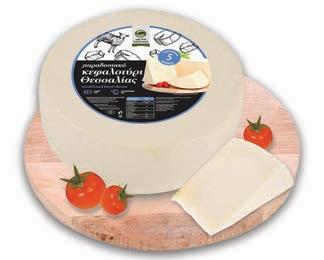
ΤΕΚΙΛΑ PATRΟN® EL ALTO
ΕΙΝΑ Ι ΕΝΑ
ΚΑ Ι ΝΟΤ Ο ΜΟ ΚΑ Ι
ΣΠ ΑΝΙ Ο ΑΠ Ο ΣΤΑΓΜΑ
ΥΠ Ε ΡΤΑΤΗΣ
ΠΟΛΥΤ Ε ΛΕ ΙΑΣ, Ο ΠΟΥ ΕΚΛΕΚΤ ΕΣ
ΠΑΛΑ Ι ΩΜ Ε ΝΕΣ ΤΕΚΙΛΕΣ
ΕΝ Ω ΝΟΝΤΑ Ι
ΑΡΜΟΝ ΙΚΑ, ΑΓΓΙΖΟΝΤΑΣ ΤΟ ΑΠΟΚΟΡ Υ ΦΩΜΑ ΤΗΣ ΤΕΛΕΙΟΤΗΤΑΣ.
PATR ΟN EL ALTO patrontequila.com
THE NEW ULTRAP REMIUM PATRΟN® EL ALTO TEQUILA IS AN INNOVATIVE AND RARE SPIRIT OF EXCEPTIONAL LUXURY, HARMONIOUSLY BLENDING SELECT AGED TEQUILAS TO REACH THE PINNACLE OF PERFECTION.


The Masoutis From Our Land range has earned a cherished place at our daily table. The Tomato and Caramelized Onion with Balsamic chutneys are exquisite companions for a cheese board or for adding a refined burst of flavor to sandwiches. The Traditional Thessaly Kefalotyri, with its subtly salty profile, is delightful served as saganaki, grated over pasta, or enjoyed simply on its own, while the Semi-Hard Cheese, with its supple, elastic texture, is ideal for both cold and warm sandwiches –and absolutely perfect for pizza.

FOR SERIOUS PASTA LOVERS mamairenepasta.gr


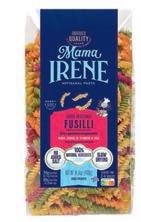
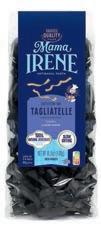
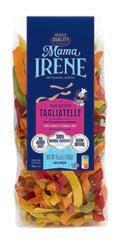
Who could possibly resist a plate of exceptional pasta? Handmade with 100% natural ingredients, MAMA IRENE ARTISANAL PASTA brings heightened flavor and character to every creation. We were particularly charmed by the vegetable fusilli and tagliatelle, as well as the deeply aromatic squid-ink tagliatelle.
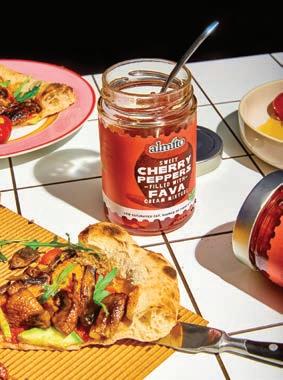



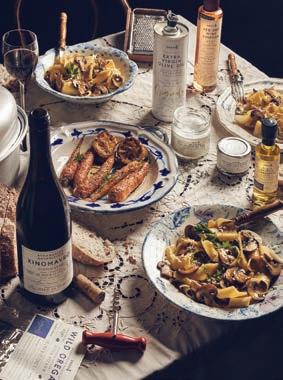

1.
� A DASH OF CINNAMON IN BLACK COFFEE REDUCES BITTERNESS AND IMPARTS A SWEET AFTERTASTE –WITH NO ADDED SUGAR!
3.
4.
5.


BY ELENI MICHAILIDOU
A FRAGRANT STORY WOVEN WITH MEMORIES, MYTHS, AND FLAVOR...
1. Cinnamon is obtained from the bark of the Cinnamomum tree – true cinnamon comes from Ceylon, and Cassia is the more common and cheaper variety.

2. It helps regulate blood sugar, and its scent can help improve memory and mental focus.
3. In ancient times, the Romans offered it to the gods, and the Egyptians used it in the embalming process!
4. According to Herodotus, the Arabs claimed that cinnamon grew in the nests of giant birds, in order to prevent others from obtaining it.
5. In the past, it was so expensive that the price of a kilogram was equivalent to a month’s salary (even more expensive in Medieval Europe).

6. It has long been associated with attracting good luck and protecting against the evil eye. Nowadays... it simply makes the home smell wonderful!
7. Cinnamaldehyde: The compound that gives cinnamon its characteristic odor and flavor. SOS: Cassia also contains coumarin, which can be harmful to the liver if consumed in excess.
8. It has antibacterial and antioxidant properties – which is why it is common in many grandma remedies for a common cold.
9. Cinnamon is quite versatile: it is added in coffees, rice puddings, cakes, and stews. Arabs add it to meat, Indians to tea, and Mexicans to chocolate! ■
2
“UPSIDE-DOWN” APPLE PIE
2 green apples, peeled and sliced
50 g butter, melted
50 g brown sugar
50 g walnuts, coarsely chopped FOR THE BATTER: 3 eggs
250 g sugar
300 g all-purpose flour
1/2 cup whole milk
1/2 cup sunflower oil
16 g baking powder
1 1/2 tsp cinnamon
1/4 tsp ground cloves Z Z
Line a springform pan with parchment paper, then coat the surface with the melted butter and brown sugar. Arrange the apple slices on top and fill the gaps between them with the chopped walnuts. Set the pan aside and preheat the oven to 180°C.
FOR THE BATTER: In a bowl, beat the eggs with the sugar using a mixer. Then gradually add all the remaining ingredients. Once the mixture forms a smooth batter, pour it carefully over the apples. Bake for 40 minutes.Let the apple pie cool completely, then invert it onto a serving platter. Serve with extra cinnamon.





Its aroma evokes memories; its taste connects generations; Greek coffee is more than a drink – it’s a ritual.
BY MANTO KORONAKOU
Greek coffee, with its rich flavor, velvety texture, and unique preparation method, is intertwined with Greek culture and hospitality. Its distinctive aroma, as it slowly brews in the socalled briki, evokes memories and emotions, turning pleasure into a daily ritual.
The art of Greek coffee lies in the details, and the following tips will help you master the traditional way of preparing it.
A proper Greek coffee is all about the blend. 100% Arabica blends offer a finer result, while adding Robusta creates a stronger body and a more intense aftertaste. Experiment to find the right blend for your palate!
A small brass or copper briki, with a narrow neck and curved body, is the ideal choice to make a traditional Greek coffee, as it distributes heat evenly and preserves the rich coffee aromas.
Greek coffee requires patience and low heat to bring out its aromas and rich flavor. Although making coffee on embers is traditionally considered the best method, the gas burner is an excellent alternative for preparing Greek coffee at home.
Pour the coffee into the cup slowly and steadily, letting the foam “settle” on top, and serve with a glass of cool water and a piece of lokum! ■
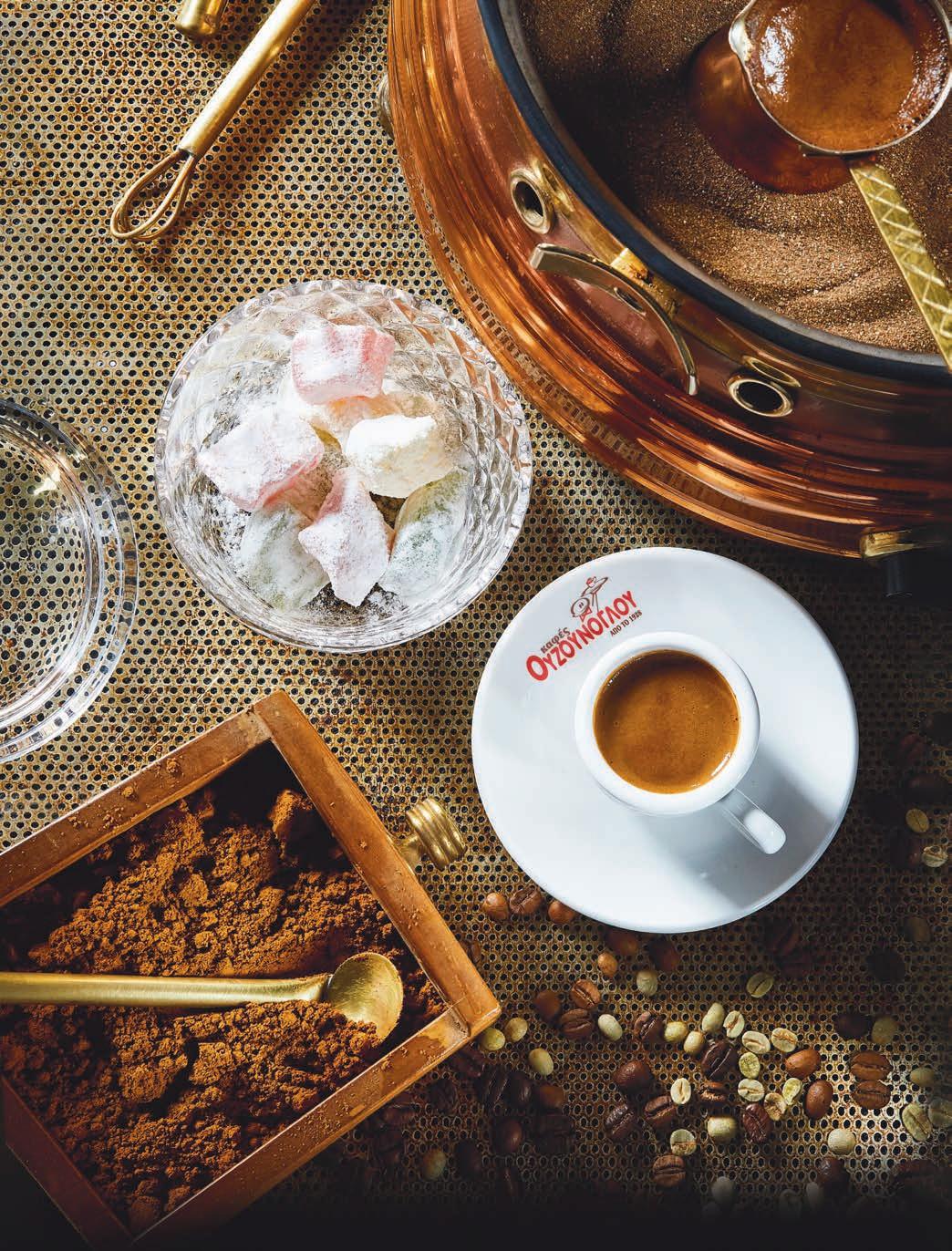


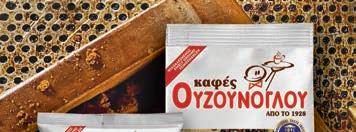




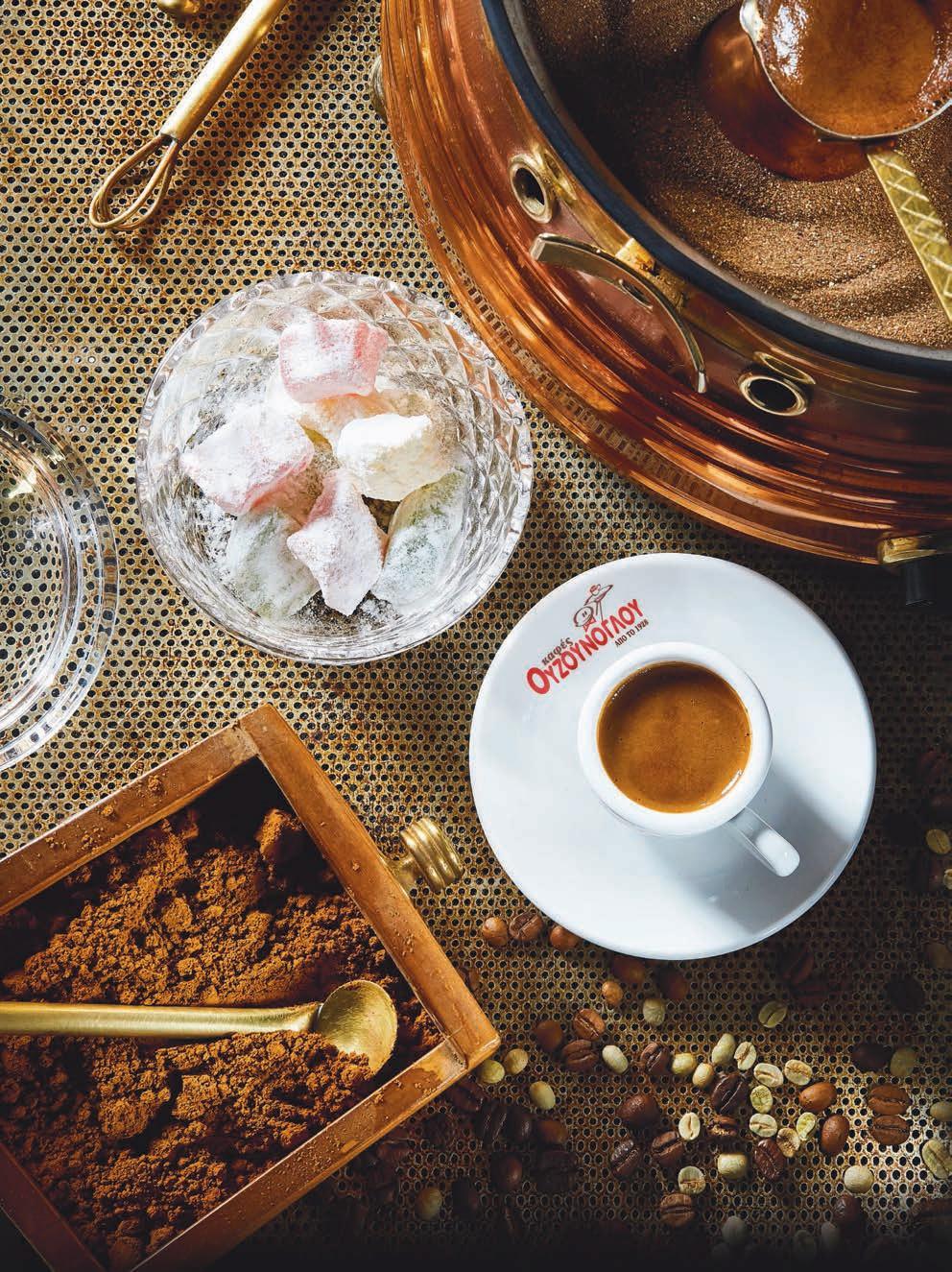
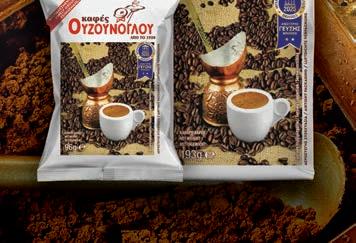


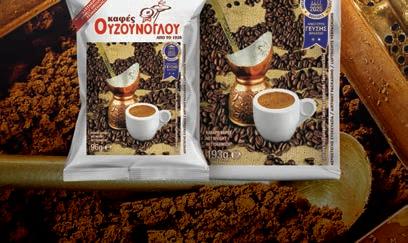







BY MANTO KORONAKOU
ROBUST FLAVOR, RICH AROMA AND ITALIAN MASTERY COMBINED, CREATE ONE OF THE MOST POPULAR AND BELOVED COFFEE IN THE WORLD: UNDOUBTEDLY, ESPRESSO! Originating from Italy, espresso is prepared using high-pressure to force hot water through finely ground coffee beans. This technique gives espresso its rich texture and unique flavor profile that set it apart from other types of coffee. In addition, espresso serves as the foundation for many other coffee drinks and it’s an integral part of everyday life for millions of people worldwide. Whether you are looking for the perfect start to your day or a momentary escape from your daily routine, espresso is always an excellent choice.
MACCHIATO is an espresso topped with a small amount of milk foam. This small “mark” of milk softens the intensity of the espresso, adding a creamy texture and a sweet, smooth note while maintaining the flavor profile of the coffee.
The classic ESPRESSO serves as the base for this coffee drink. It’s characterized by a robust, rich flavor and a dense texture, while its creamy surface adds a smooth and aromatic note.
Ο LUNGO
LUNGO is a variation of espresso made using a larger amount of water with the same amount of coffee grounds. The result is a more diluted coffee with a milder taste, and less intensity compared to a classic espresso, while retaining its distinct aroma. It’s ideal for those who enjoy a gentler taste profile, with a rich aroma and complex flavor still present.
RISTRETTO is a shorter and more concentrated version of espresso. The same amount of coffee is used, only with less water. This method of preparation results in a more intense, rich, and sweet coffee, as the extraction time is shorter. Ristretto is preferred by those who seek a small volume of coffee with a bold flavor. ■
DOPPIO - or double espresso - consists of a double shot of coffee and it’s perfect for those opting for a strong and concentrated coffee. It’s prepared with double the amount of coffee grounds, offering a robust and rich flavor while preserving the flavor profile of the classic espresso, only with greater intensity and lingering aftertaste.

WHICHEVER VERSION YOU PREFER, REMEMBER THAT IN THE WORLD OF ESPRESSO, EVERY SIP IS A WAY OF LIFE!
BY ELENI MICHAILIDOU || PORTRAIT IMAGE: CHRISTINA BROUSALI
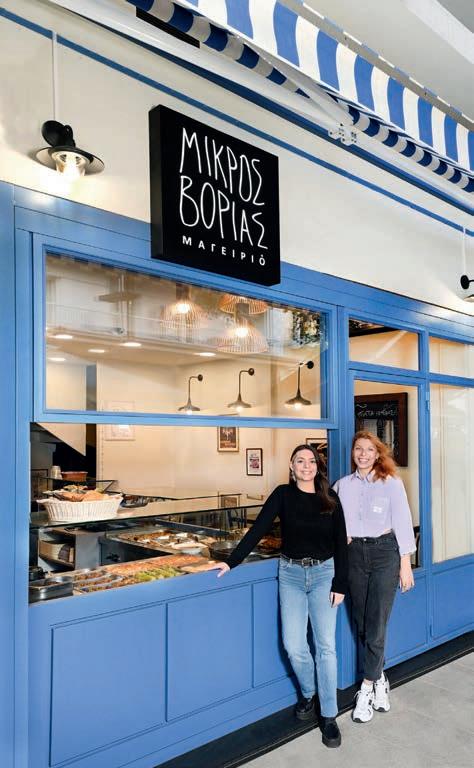
Panas Holding.
LATE 1990S. RIGHT IN THE HEART OF THESSALONIKI’S HISTORIC CENTER, SOMETHING WAS “BORN” THAT WOULD FOREVER CHANGE THE WAY WE ENJOY STREET FOOD IN GREECE – PATAFRITAS.
The corner of Tsimiski and Aristotelous has become a landmark for the city and its people ever since. Students, teens hanging out in the city center, families; they all gather at Patafritas, Greece’s first street food concept – no tables, no service, yet, the tastiest French fries, drenched in warm dipping sauces, crispy bacon, and feta sauce!
The source of inspiration was a trip to the Netherlands that Mr. Damianidis and his wife took. Inspired by the French fries they tried on the streets of Amsterdam served with mayonnaise, they acknowledged the distinctive element of simplicity

and decided to bring it back to Greece on their own terms. A simple, yet bold idea that made the humble potato the star and marked the beginning of Panas Holding.
After Patafritas, the grillhouses Ladi kai Rigani and Gyros Proedrikos followed, which once again turned the spotlight on souvlaki and gyros, our favorite food while growing up. At the same time, Mikros Vorias brings “delicious, freshly prepared home-cooked food” to our plates as Eleftheria Damianidou states.





Eleftheria and her sister Violeta, second generation at the helm of Panas Holding, literally have “food in their DNA” – as they so rightly put it – and are evolving the company’s vision by introducing new concepts, based on authenticity and strategy. In this case, it was their experiences abroad that lead to the creation of Esteban. A burrito bar, described by Violeta as an “authentic, delicious and timeless casual street concept”. Esteban meets Patafritas on Aristotelous Street, a blend of tradition and outward-looking spirit. “We choose to stay true to ourselves and evolve in a proper, sustainable manner, always focusing on the quality that defines us”, says Eleftheria.
Nowadays, Panas Holding has nine stores in Thessaloniki and Athens and continues to grow with planning, character, and respect for its identity. As the two sisters say, “We are not fans of trends – we want to create things that last. Better less and authentic, rather than hasty and superficial”.
From the corners of Thessaloniki and Athens to the forthcoming projects at The Ellinikon, Panas Holding is a family story full of flavor, consistency, and emotion – proof that even if something starts with just “an idea”, it can become a food memory and a story that entire generations can taste daily. ■


Orange Spritz,
Pink Grapefruit, Mojito & Passion Fruit
Green
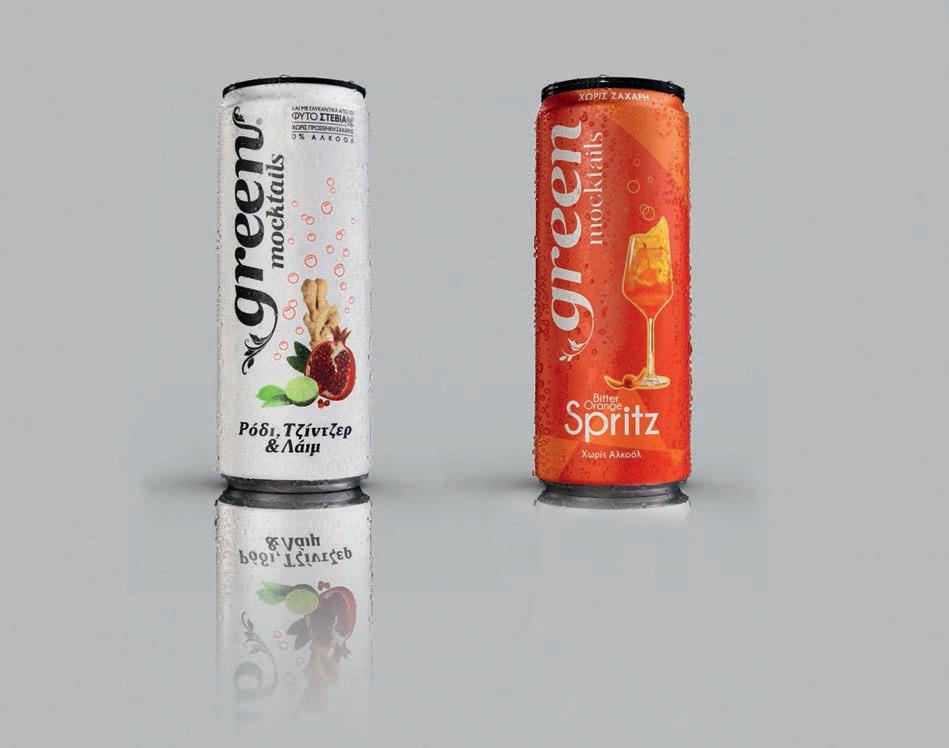

The much-loved Green Mocktails series has won the hearts of consumers as they blend unique taste, natural ingredients, and an uncompromising experience. With no added sugar and no calories, Green Mocktails serve as an excellent option for those seeking quality, authenticity, and guilt-free pleasure.
Perfectly delicious with fruity flavors like Bitter Orange Spritz, Pomegranate, Ginger & Lime, Pink Grapefruit, Mojito & Passion Fruit, Green Mocktails are the ultimate re-
freshing treat for any time of day. You can enjoy them on their own as refreshing soft drinks or in combination with your favorite alcoholic beverage without guilt, as they contain 0% sugar, 0% calories, and 0% alcohol.
Green Mocktails redefine the concept of delightful flavor. From home and office to parties or a night out, they make a standout choice for any occasion. Enjoy the freshness, feel revitalized, and indulge in the thoughtfully crafted experience of Green Mocktails!
BY ELENI MICHAILIDOU
|| PHOTOGRAPHER: THEODOSIS GEORGIADIS || CHEF: ANDREAS KLAVDIANOS || FOOD STYLIST: STAVROULA FOUTSA ALL PRODUCTS: MASOUTIS
“The ingredients of a successful radio program are the producer’s enthusiasm and interaction. The listener chooses to tune in to a radio program to have fun, to be entertained, or get informed, and to feel like a protagonist. Of course, humor also plays a huge role. At the end of the day, people remember whatever made them laugh.”
I love Italian cuisine. I recently visited Milan and Bologna and I was impressed. Everything I tried was exceptional – from the pasta and pizza to the bruschettas on the street.”
“Food tastes better when shared, and I think elate stands out for this reason. The open kitchen is its trademark. Everyone is impressed by the large pass and the cooking that takes place before their very eyes. Then the table is set, where we eat and share stories worth telling.” ´
Genuine, open-minded, and with a great sense of humor, Efthimis Kalfas enters the kitchen, cooks chicken with pilaf, and talks about the radio, food, his love of sharing, and the importance of laughing every day –even at yourself.




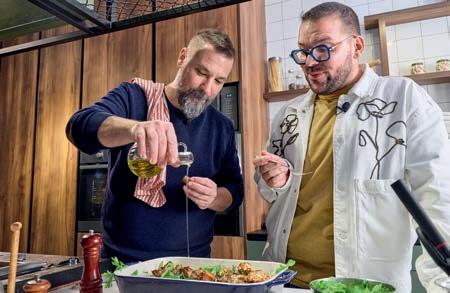
If you think about it, life’s most important moments –both joyful and sorrowful– are experienced when gathered around a table. It’s part of our culture. It’s our way of showing we care. Food is a hug – an act of love.”
“We should not only look for reasons to laugh during the day, but also create them. It may sound cliché, but laughter makes even the hard things feel less overwhelming. It smooths out our edges...”
I take pleasure in cooking for the people I love, but I don’t like cooking for myself. Having guests over and setting the table is my way of expressing love and affection.”
“School didn’t come easy for me. I went through phases of loneliness, bullying, rejection. However, looking back, I understand how that period has shaped me. I would close my bedroom door and listen to the radio for hours. I felt like there was someone keeping me company. When asked ‘What do you want to be when you grow up?’ in a career counseling course, I said: ‘I want to be a radio producer. To keep people company; people who are alone in a room listening to the radio.’”
Show me you know how to make an authentic carbonara – crack the egg, sauté the guanciale –and you’ve won me over, even if it’s not perfect. If you use heavy cream… it’s game over!”
“My winter comfort food is chicken soup – a hug on a plate. In summer, it’s eggplants with THE meat – as my mother typically calls it. It’s a hassle to make, but it feels like home.”

Z
t i is avorite reci
N Z

OVEN-BAKED CHICKEN WITH PILAF
1 whole chicken, deboned and cut into portions
1250 ml chicken broth
500 g Carolina rice
1/2 bunch of spring onions
5 tbsp mustard
5 tbsp honey
5 tbsp balsamic cream
250 ml olive oil
120 g roasted hazelnuts mint, parsley, dill (one bunch each) salt blossom, freshly ground pepper
All products: MASOUTIS
In a pot of boiling salted water, add the chicken and boil for about 20´.
Mix the mustard, honey, balsamic vinegar, half of the olive oil, salt, and pepper in a bowl. Grind half of the hazelnuts in a food processor and incorporate them into the mixture. Add the boiled chicken and allow to marinate for about 20´.
Rinse and drain the rice very well and place it in an ovenproof dish. Cut the spring onions into thin slices and sprinkle half over the rice. Add 1250 ml of broth from the pot the chicken was boiled and season with salt and pepper.
Thread the marinated chicken pieces onto a small skewer, carefully place it over the rice, and bake in a preheated oven at 180°C for about 40´.
Strip the leaves off the dill, mint, and parsley and use as garnish. Add the remaining spring onions, the rest of the hazelnuts, coarsely chopped, a little salt blossom, freshly ground pepper, and a few drops of olive oil.
“My mom’s cake and the smell of raw dough, take me back to my childhood. I remember my brother and I diving into the bowl without a shred of mercy! Still, to this day, mom’s cake awaits us on the kitchen counter every week. I know the recipe by heart – it’s etched in my DNA!”
When I first went to Athens, I refused to call the souvlaki "kalamaki", which was what they wanted to hear. Nevertheless, I had to give in because my order had to be prepared at some point! It will always be souvlaki for me! It’s like the debate about "feta" and "cheese". But now, it’s a whole lot easier for me. Do you say "cheese pie" or "feta pie" my friend? You say cheese pie! Mic drop!”
“If Thessaloniki were a dish, it would be Smyrna-style soutzoukakia with rice – traditional, with history, different influences, and just the right amount...of cinnamon. For Athens, I would choose a dish I’ve recently tried at a new restaurant, “Athos”. Beef cheek pasta – Loved it!” ■

SCAN THE QR CODE READ THE FULL INTERVIEW AND WATCH EXCLUSIVE BACKSTAGE FOOTAGE.


400
8











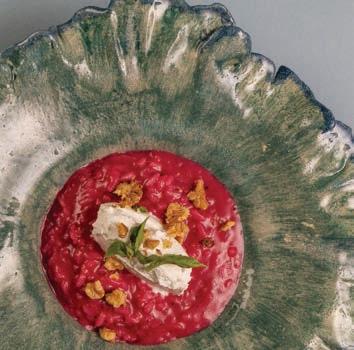


2

600
600

100
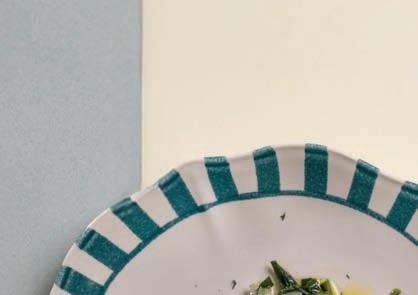
















240
100
100
100
100

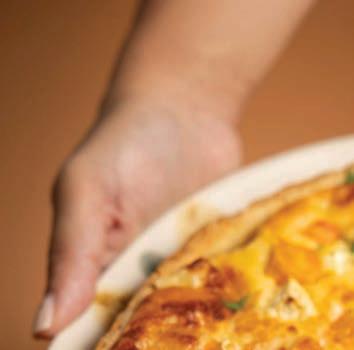



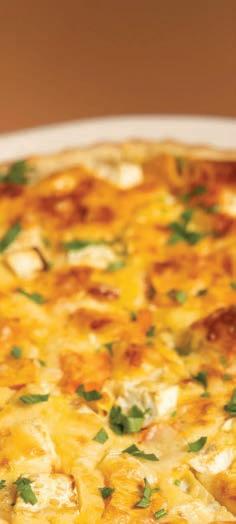






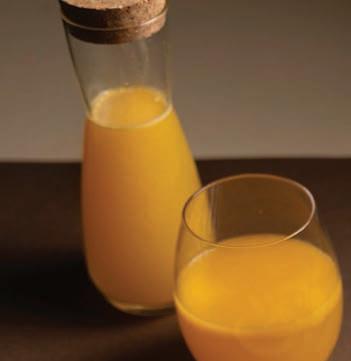









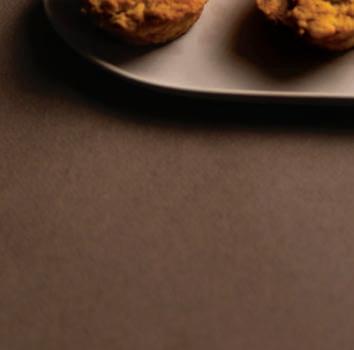








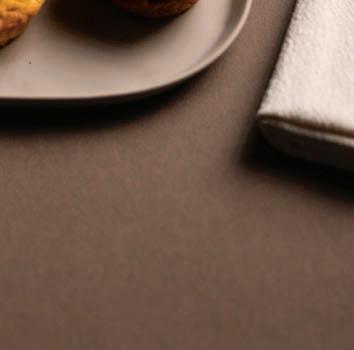






BY MINA AFENTOULI
Close your eyes and feel the rich notes of Metsovone in your mouth, the saltiness of feta, the buttery texture of manouri. Don’t set the table without a slice of pie from Epirus. Complete the puzzle of pleasure with a glass of tsipouro or debina. Finish your meal with Gianniotiko baklava and kataifi – oh, this fragrant Epirus butter truly works miracles!
While crossing Epirus, you’re not just traveling through space, but also through time – time intertwined with legends, dark lakes, and oracles. You can still hear the whisper of Hermes as he ferries the souls of the dead across the Acheron River. A little further, the Necromanteion stands silent, yet full of voices from other worlds, where the living would seek oracles from the dead. Further north, in Dodoni, Zeus answers you with the rustling of the leaves of the oak tree. It’s where words are not spoken, but you feel them penetrate your skin. And then, the Bridge of Arta is not just a stone bridge. It’s a tale of hearts and sacrifices haunted in its foundation. Lake Pamvotis embraces the island of Kyra Frosini in Ioannina, where the mist keeps the beauty that was unjustly drowned alive and Baubo still laughs somewhat ironically from the depths of the lake.
This land, the land of mountains, rocks, and rivers, is privileged with infinite beauty and natural wealth. You start at
The power of pristine nature, the vastness of the landscape, and the authenticity of its people are encapsulated in a single bite, a sip, a recipe.
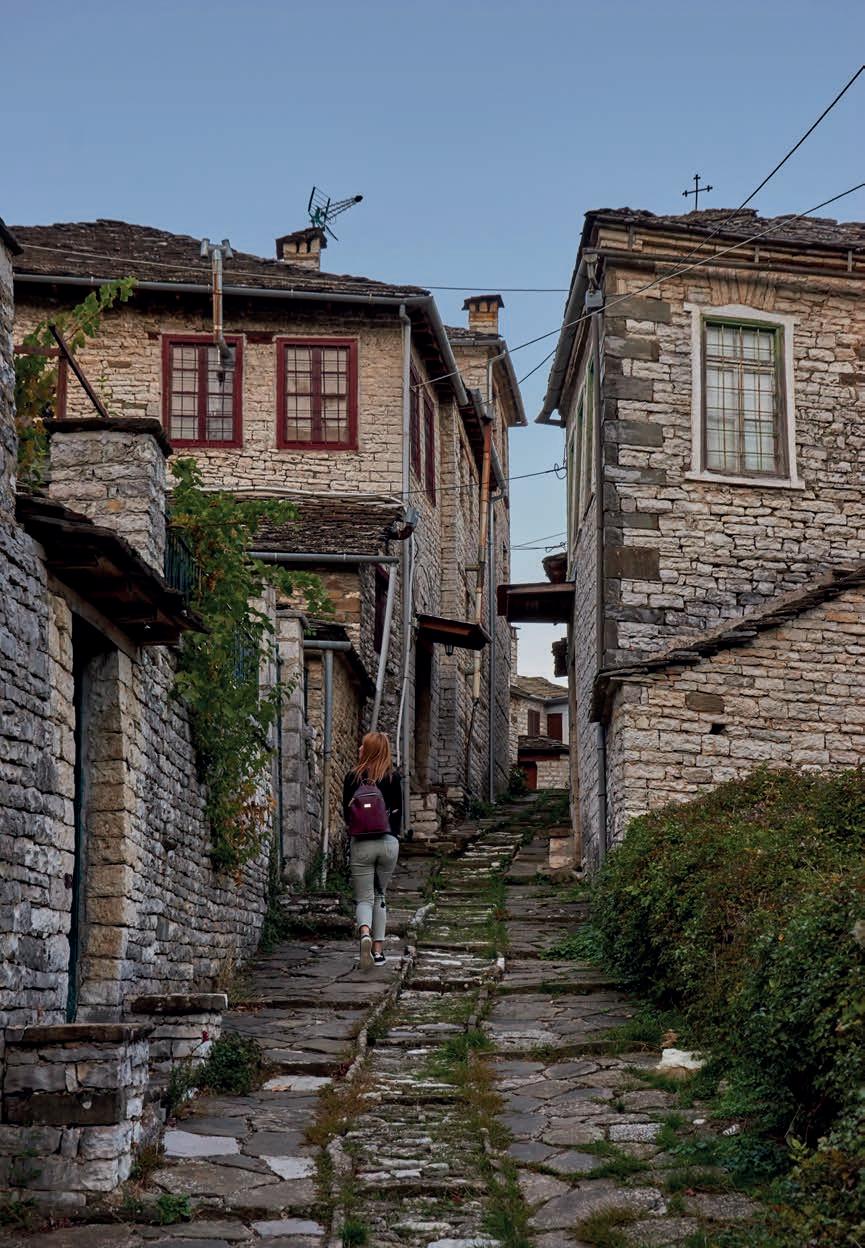
the Albanian border and the prominent Pindus mountain range to end up south, at the Ionian Sea and the Ambracian Gulf. In the course of this journey, you encounter historic towns and villages, such as Ioannina and Metsovo, Arta and Preveza, Dodoni and Zitsa, Zagorochoria and Parga.
Epirus, a rugged, yet fertile terrain, boasts a nutritional treasure based on its rich livestock tradition.The growth of the cheese industry is in no way coincidental; it’s due to the traditional knowledge of the locals, who started out in Preveza and laid the foundations for modern, high-quality production. Nowadays, leading cheese-making units are based in Dodoni, known for the international appeal of their products.
The contribution of Evangelos Averoff-Tossizza was significant in the development of Metsovo during the 1950s and 1960s. He founded a model cowshed and a cheese-making plant, sent young people to Italy to study the art of cheese-making, and laid the foundations for the famed production of Metsovone.
As a P.D.O. product, Metsovone is produced exclusively in the region of Ioannina, specifically in the region of Metsovo. It’s one of the most popular and distinctive Greek cheeses, and the


most widespread product of the Tossizza Cheese Factory. Its characteristic shape is due to the elongated molds in which it is placed, and the part of the protruding cheese mass, allowing it to be grasped and removed from the molds.
These high-quality products from Epirus have achieved recognition beyond the borders of Greece.
Of course, feta is one of the main products inextricably linked to Epirus.The region, due to its ideal geological conditions and abundance of goat and sheep milk, is rightly regarded as the mother of Greek feta.
Galotyri, a spreadable cheese with a creamy texture and slightly spicy taste, is yet another cherished product of the region.
Zemitha holds a special place among the products of Epirus, an innovative cheese made from whey.
Epirus also produces milk butter, sheep butter, and Corfu butter. The region is also known for its yogurt production.


Livestock farming and the hunting tradition of Epirus have produced outstanding products, often maturing under natural conditions, without preservatives, such as naturally-matured wild boar or venison sausages and smoked meat and syglino.
The mountainous terrain of Epirus provides an ideal environment for free-range farming.
Poultry raised on natural feed, offer meat that is both tasty and healthy.
Countless beekeeping establishments produce the so-called “golden” treasure – the famed Epirus honey. In particular, pine honey, fir honey, thyme honey, and heather honey...
In a region with exceptional honey and butter, syrup desserts could not but be the protagonists. It’s no coincidence that Gianniotiko and Klostari from Konitsa are so popular.
Between the deep gorges and stone villages, aromatic distilled spirits and wines with distinctive characteristics tell their own stories. In Preveza, the distillate of tradition flows from the stills of local producers, crafted with care and passion from high-quality pomace.
In the semi-mountainous area of Zitsa, viticulture has a centuries-long history. The most prevalent variety in the region is Debina, a rare white wine grape variety that produces aromatic, vibrant wines with characteristic acidity and elegance.
Along with Debina, varieties such as Zampela and Vlachiko contribute to the presence of more distinctive, local wine labels, often with limited production but high tasting interest.

































It’s no coincidence that Epirus produces the most awarded bottled waters in Greece. After the water’s long journey through the underground rocks of the northern Pindus region, where it naturally acquires its unique composition, the Natural Mineral Water ZAGORI is bottled directly at the source, without human intervention at any stage. The region’s natural purity is evident in the quality of the waters of Epirus – a distinctive purity also associated with the spirits and wines of the region.
For the people of Epirus, pies are more than just food; they are at the heart of local cuisine and hospitality.
Kasopita, with phyllo pastry and rich feta cheese, is made without eggs and milk. The meat pie, most often festive, contains minced meat cooked with onion and spices. The vegetable pie, depending on the season, is made with nettles, hartwort, spinach, or other wild greens, and it often contains trahana or rice.
The flour pie (batsaria) stands out in Zagori, made without phyllo, using flour, yogurt, and feta. Kothropita is one of the most unique and distinctive pies of Epirus. It resembles an open rice pie, but its crust encloses the boiled meat, and rice cooked in its broth.
The traditional pasta of Epirus, such as hilopites, tutumakia, and trahana (sweet or sour), are famous for their unique taste. Epirus is also a mushroom lover’s paradise. Its forests host dozens of wild mushroom species, with the most sought-after being black and white truffles. Taverns serve a unique local delicacy at the picturesque Nissaki of Ioannina: frog legs. Fried or cooked with garlic and lemon, they taste like chicken and it’s a unique culinary experience for visitors.
The running waters of Epirus are ideal for natural trout farming. Fresh or smoked, trout has become a sought-after product for fine dining restaurants.
For the grand finale, I leave you with the Ambracian Gulf Avgotaracho (bottarga) – one of the most distinctive and exquisite Greek P.G.I. products (Protected Geographical Indication). It’s produced from the female flathead grey mullet encountered in the lagoons of the Ambracian Gulf. The roe sacs are naturally dried and coated in beeswax, resulting in a product of high nutritional value, rich in omega-3 fatty acids, with a delicate salty flavor and aromatic complexity. ■










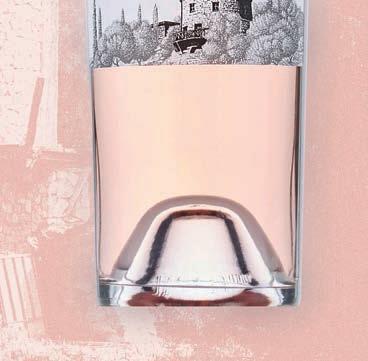



BY SOMMELIER / WINE CONSULTANT ΑLEXANDROS BOUZIKAS

For wine connoisseurs, the designation Vieilles Vignes or Old Vines on wine labels suggests depth, complexity, and high quality. However, the scientific grounds for this opinion remain unclear.
Winegrowers and oenologists argue that older vines produce fewer grapes, smaller in size and more concentrated. Their deep roots absorb rare minerals and experience more stable temperatures and humidity. In addition, old vines host richer microbial communities, which may contribute to creating more complex and “distinctive” wines. Still, scientific studies show conflicting results, and factors such as microclimate, soil, farming practices, and clones significantly affect the end quality.

As climate change is transforming the landscapes of winemaking worldwide and redefining the concept of “terroir,” old vines may hold answers regarding the quality, resilience, and authenticity of tomorrow’s wine. However, the following question needs to be addressed: Are old vines superior in quality, and can they serve as a shield against the climate crisis?
Survivor
Ancestor
According to South Africa’s Old Vine Project, “old vineyards are a source of knowledge, especially in this challenging time of climate change.” This initiative maps and safeguards vines over 35 years old, acknowledging their contribution in preserving varietal identity and biodiversity.
Similarly, the Barossa Old Vine Charter in Australia classifies wines into categories: Old Vine: over 35 years old
Survivor Vine: over 70 years old
Centenarian Vine: over 100 years old
Ancestor Vine: over 125 years old
These vines, with lower grape yields but deeper roots, produce wines with high density, balance, and distinct climate resilience.
Wine-producing regions such as South Africa, the Mediterranean, and Australia are particularly vulnerable to extreme weather conditions, which directly affect production and quality. Nowadays, they are faced with exceptionally warm years, prolonged drought, uneven rainfall distribution, and significant variation in temperature, leading to early harvests, high sugar and alcohol content, reduced acidity, lack of phenolic ripeness, and loss of typicity.
In this respect, old vines have certain adaptability advantages:
Their deep roots offer an enhanced resilience to drought, as they can access moisture deep in the subsoil.
They are resistant to thermal stress, leading to a balance of yield and ripeness without excessive intervention. They’ve been gradually adapting to the region’s microclimate for decades, making them more resistant to weather volatility.
Andrew Jefford wrote an interesting article for Decanter (“Soil & Terroir Tracking”) analyzing the idea that soil is not just a substrate, but a living ecosystem. Old vines appear to develop a microbial “world” after decades of coexistence with the same soil, thus enhancing the plant’s resilience.
«NOT EVERY VINEYARD IS A LITTLE CORNER OF PARADISE – BUT THOSE WHO HAVE STUDIED THEIR OWN VINES ALLOW THAT THERE ARE SOUND REASONS FOR RESERVE ABOUT SOME OF THE WILDER CLAIMS.»
Andrew Jefford, Decanter
However, the climate is changing at an unprecedented rate and natural resilience may prove insufficient. Soil management, variety renewal, and the use of new irrigation techniques are becoming essential.
At a time when the search for more resilient varieties and new cultivation techniques are considered imperative, old vines may offer natural advantages that are difficult to replicate artificially. Therefore, instead of trying to “fix” nature through technological means alone, perhaps we should once again turn – quite literally – to the roots that have already stood the test of time! ■




